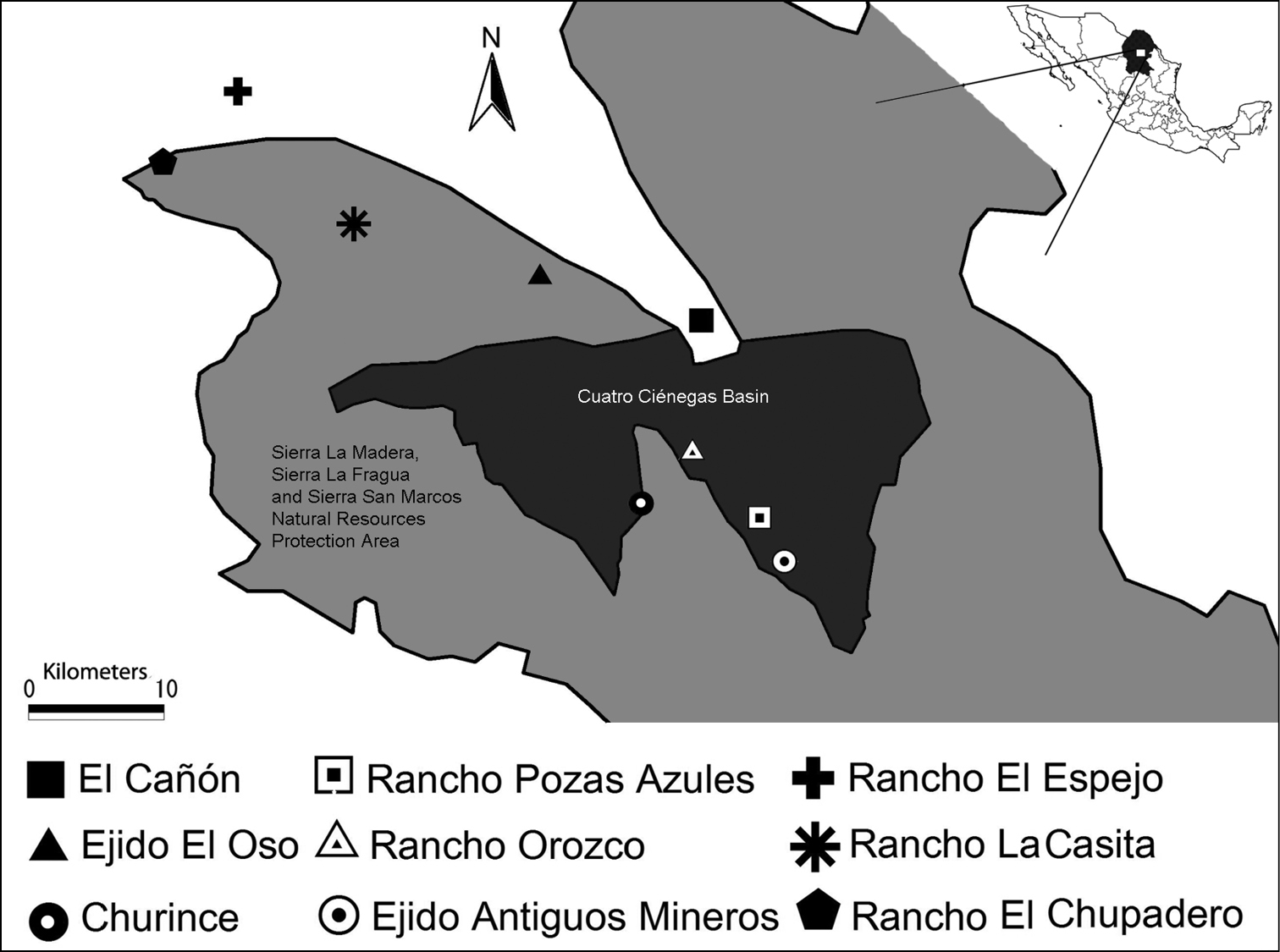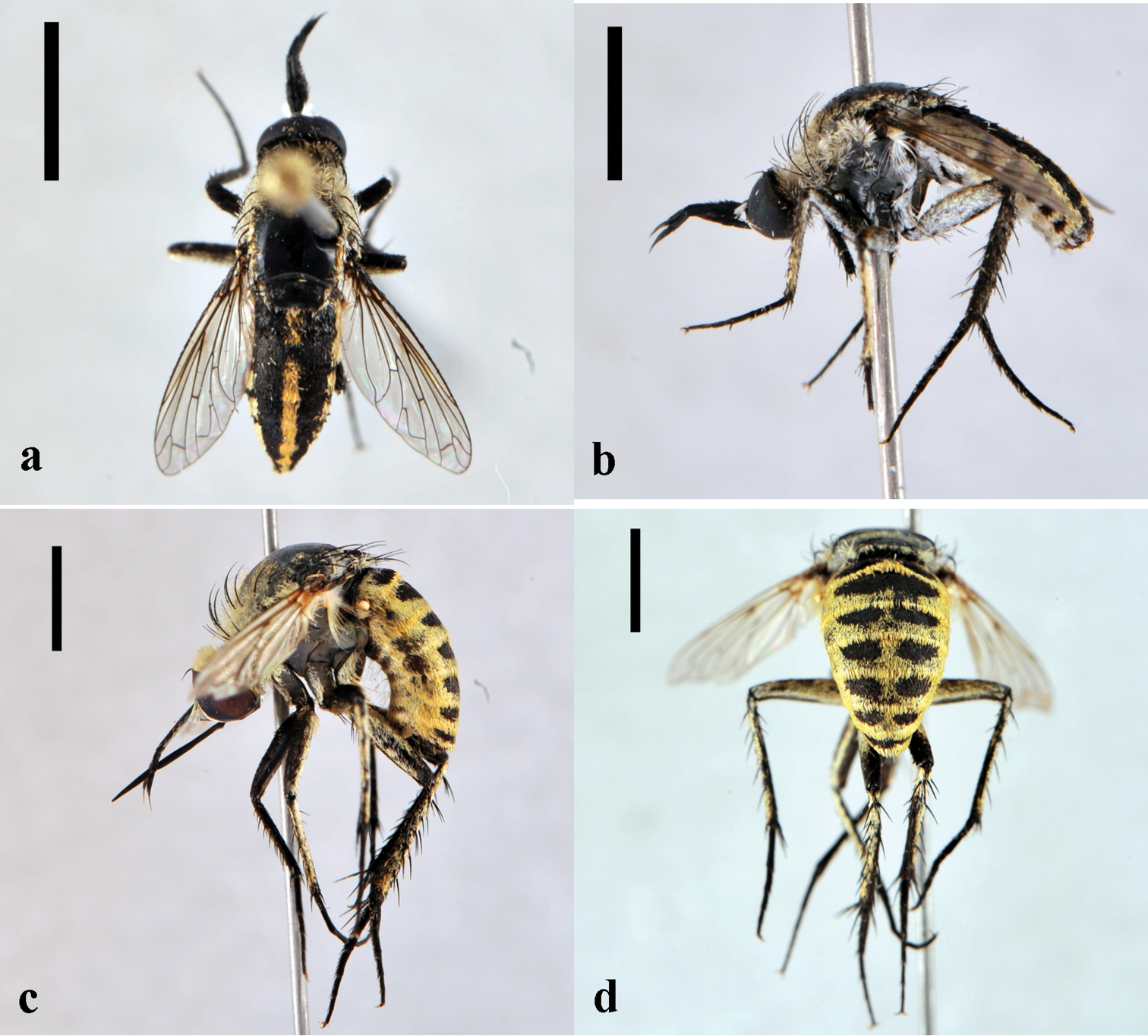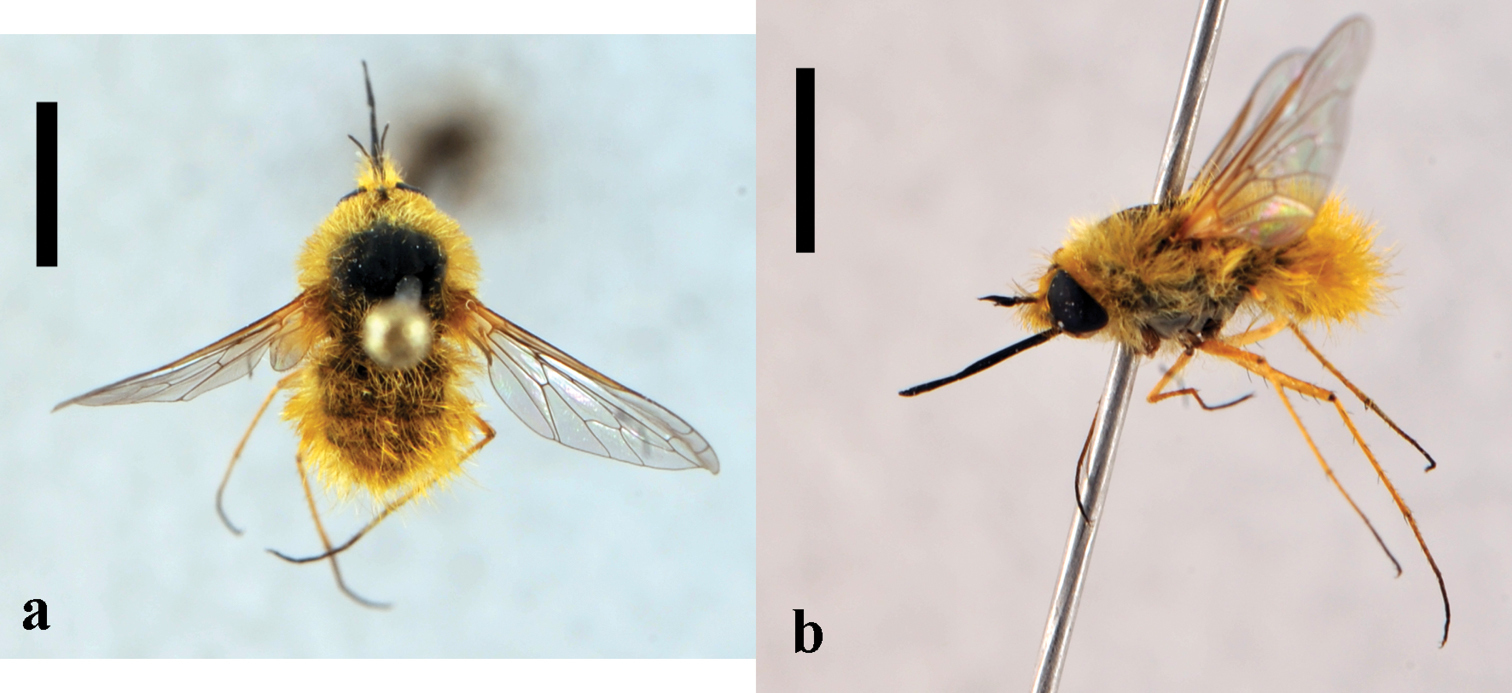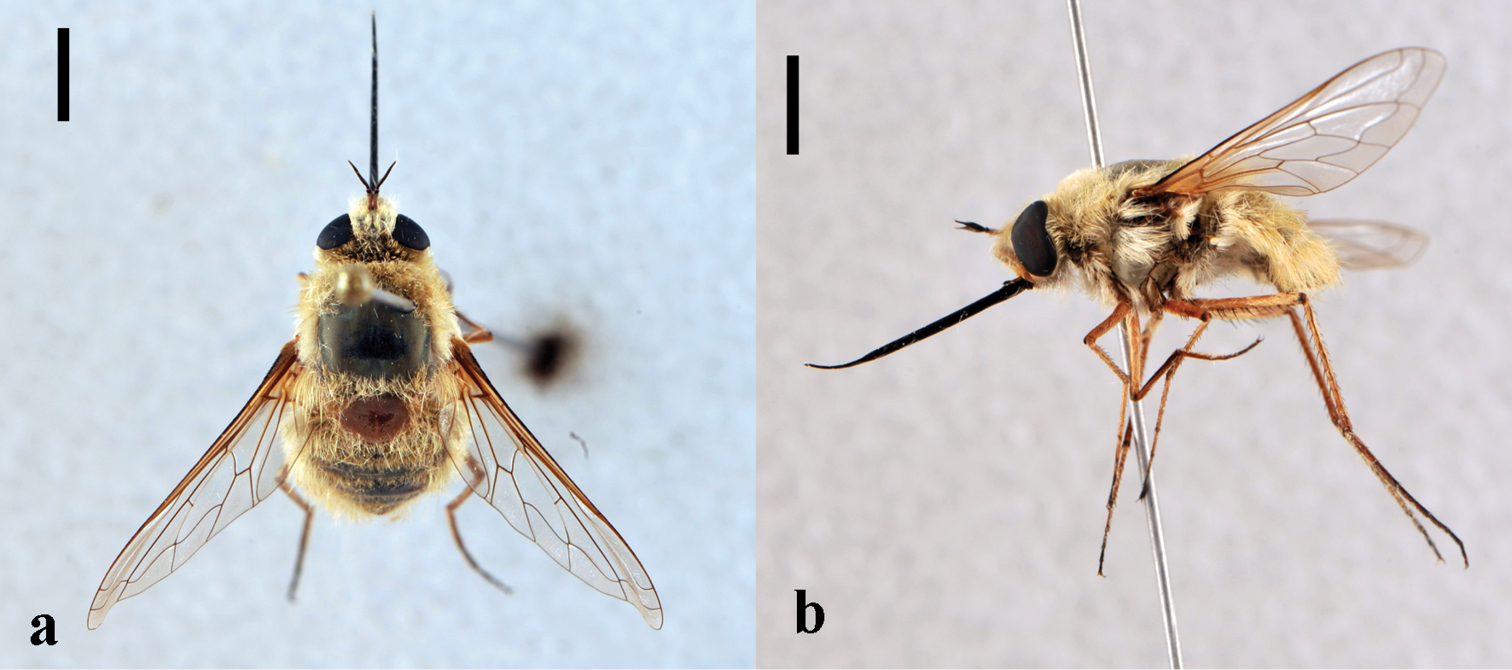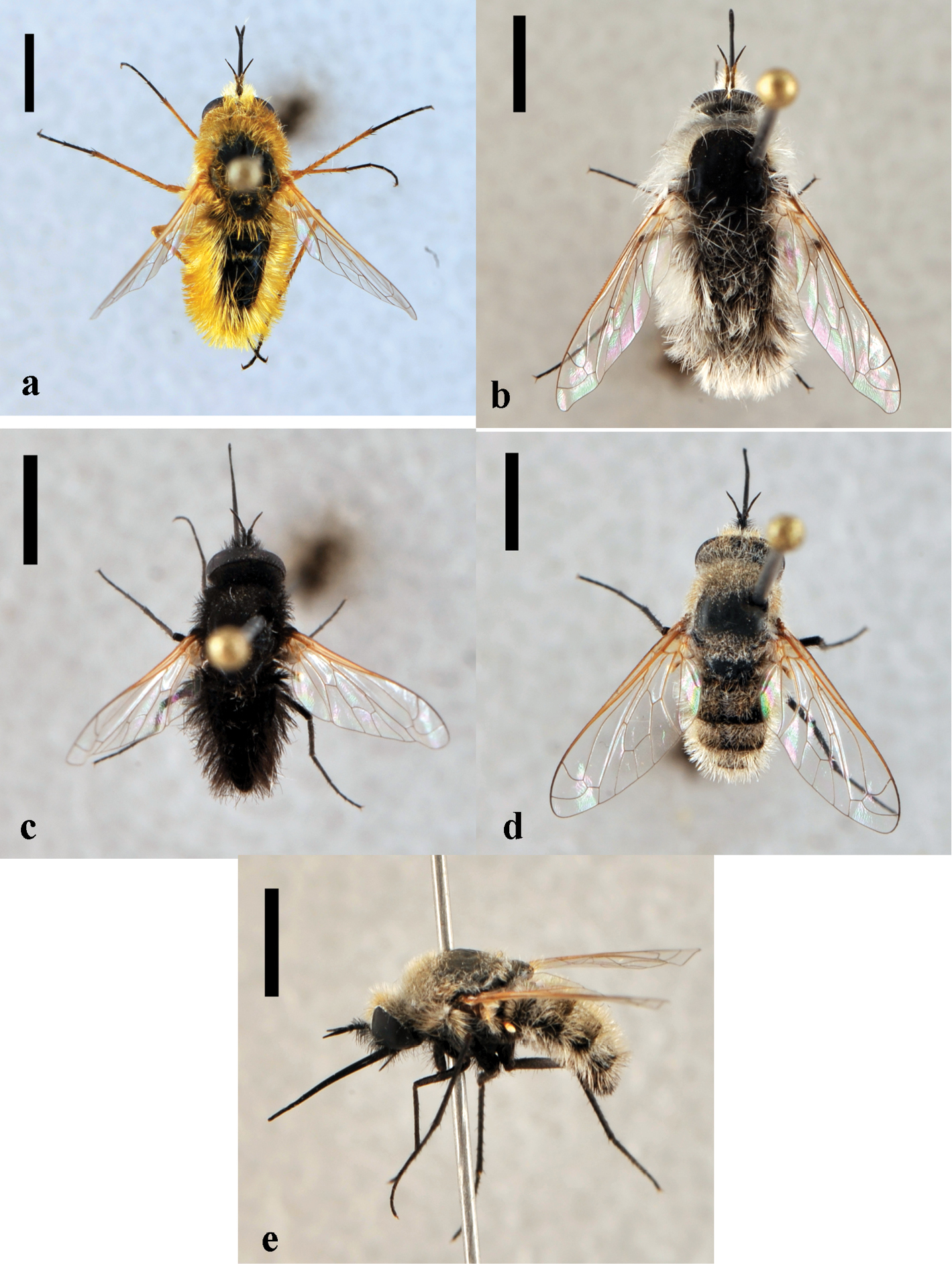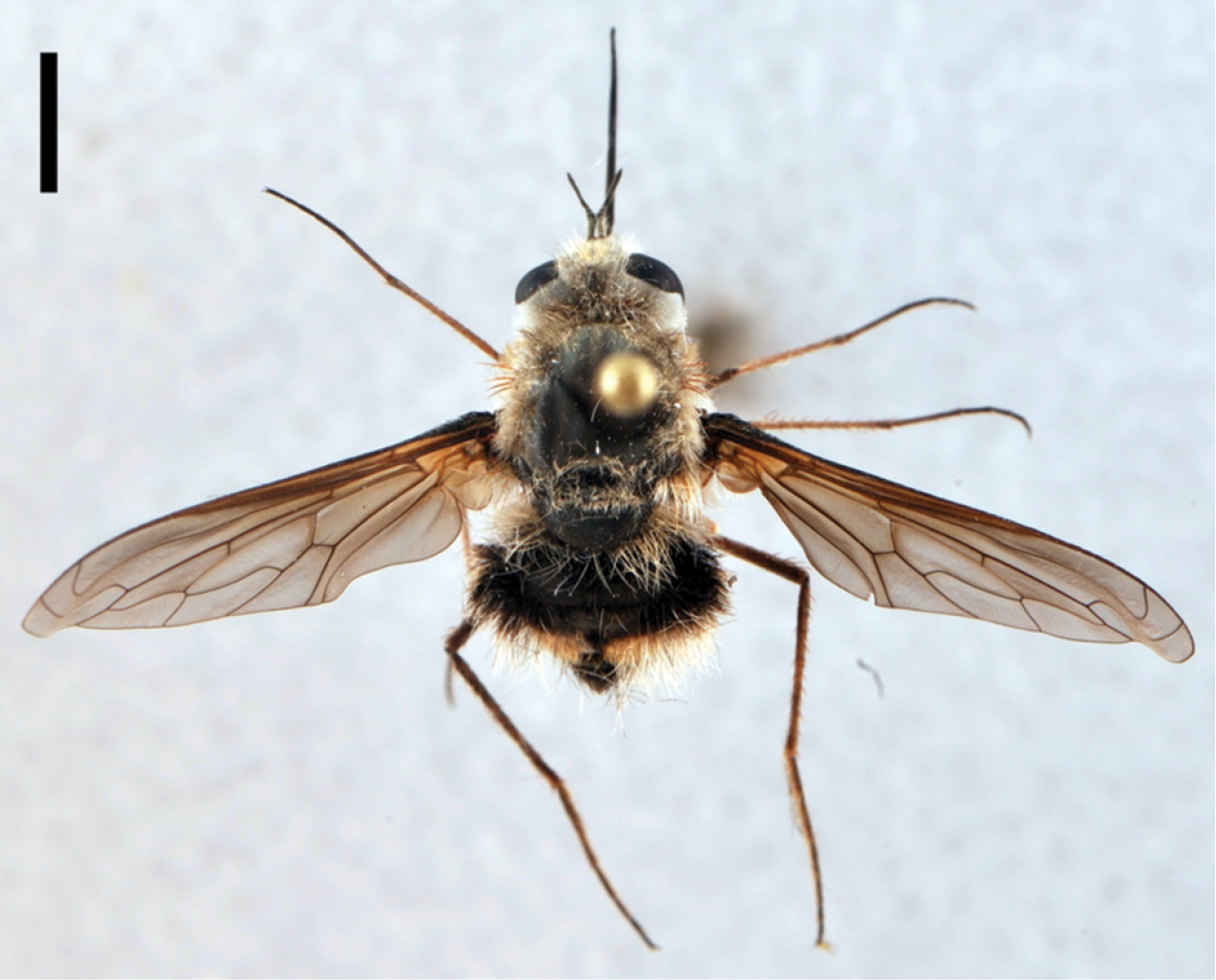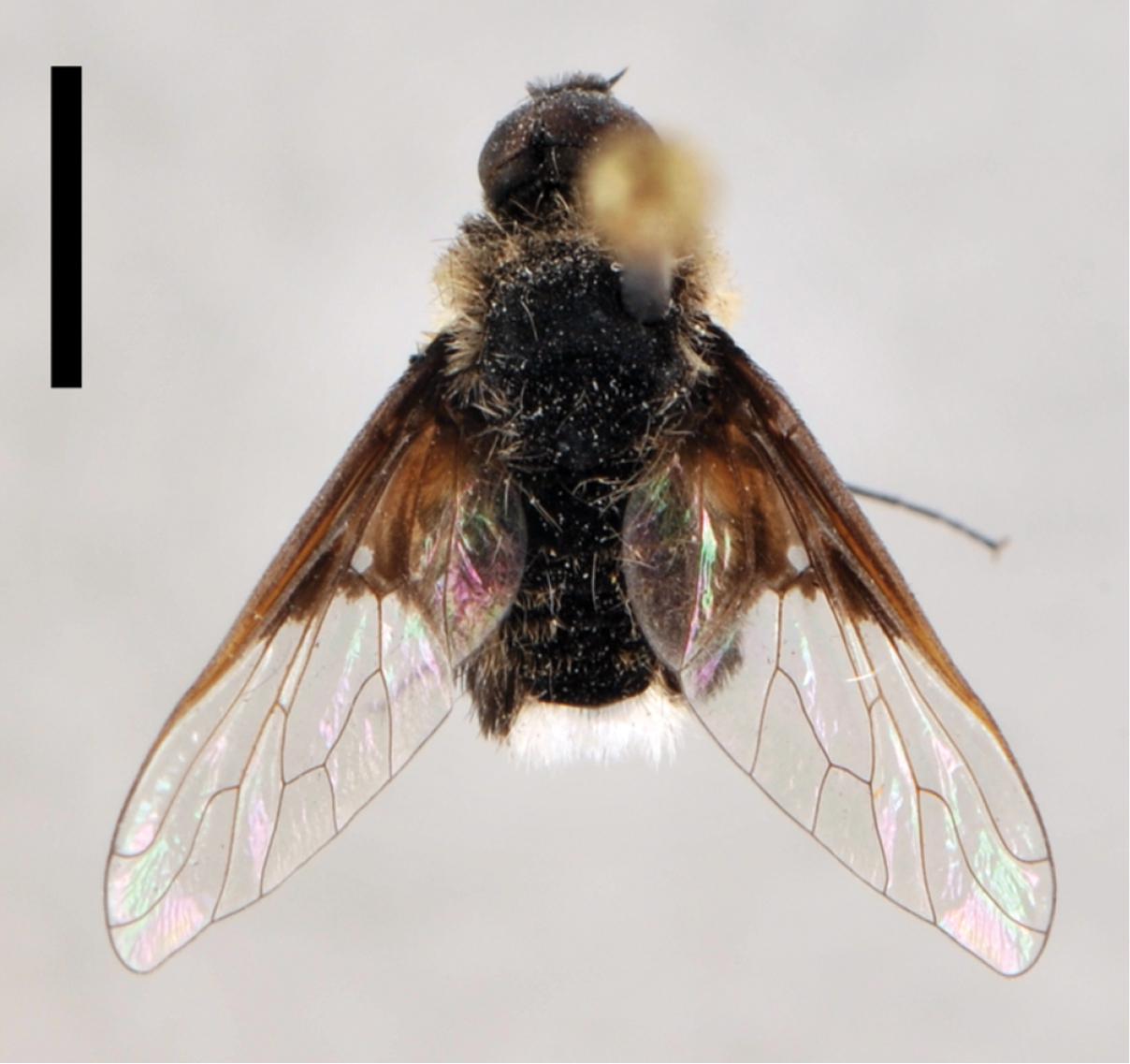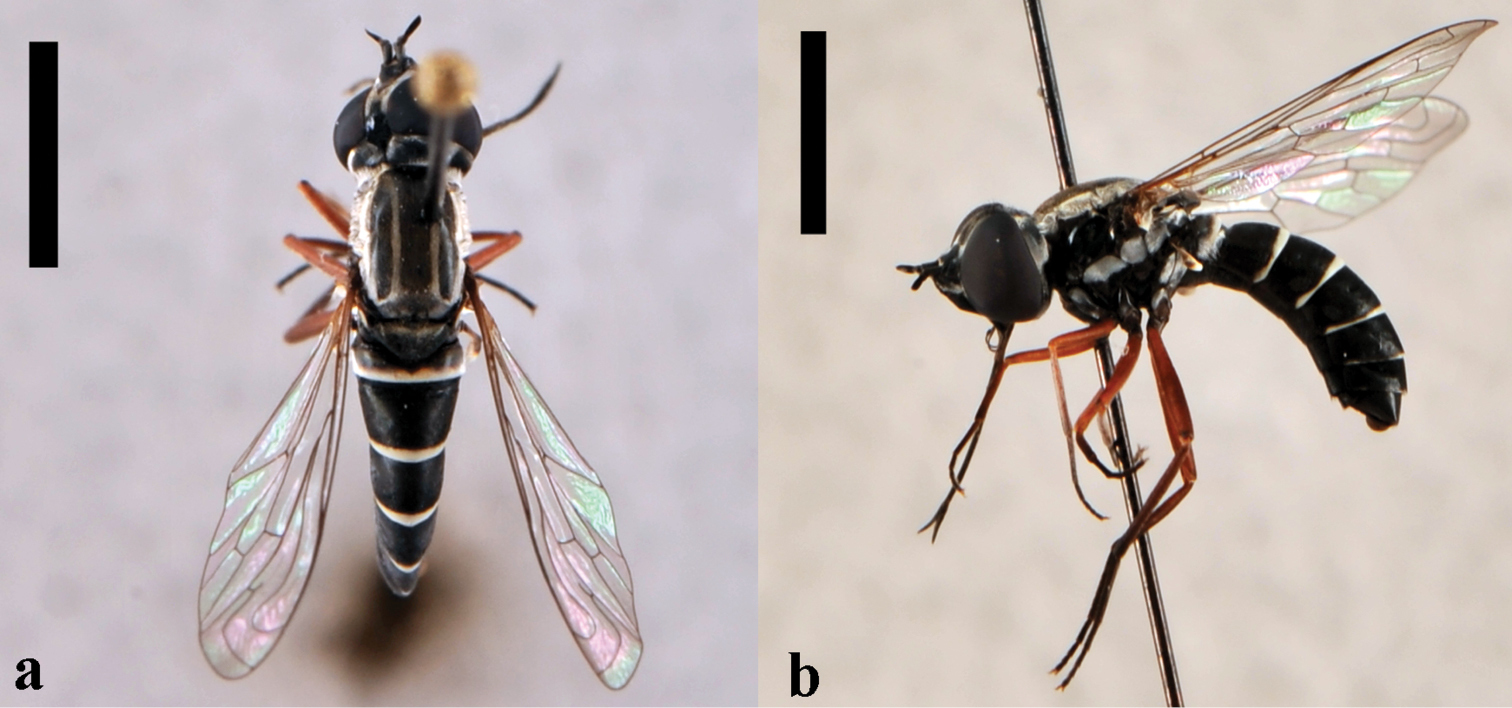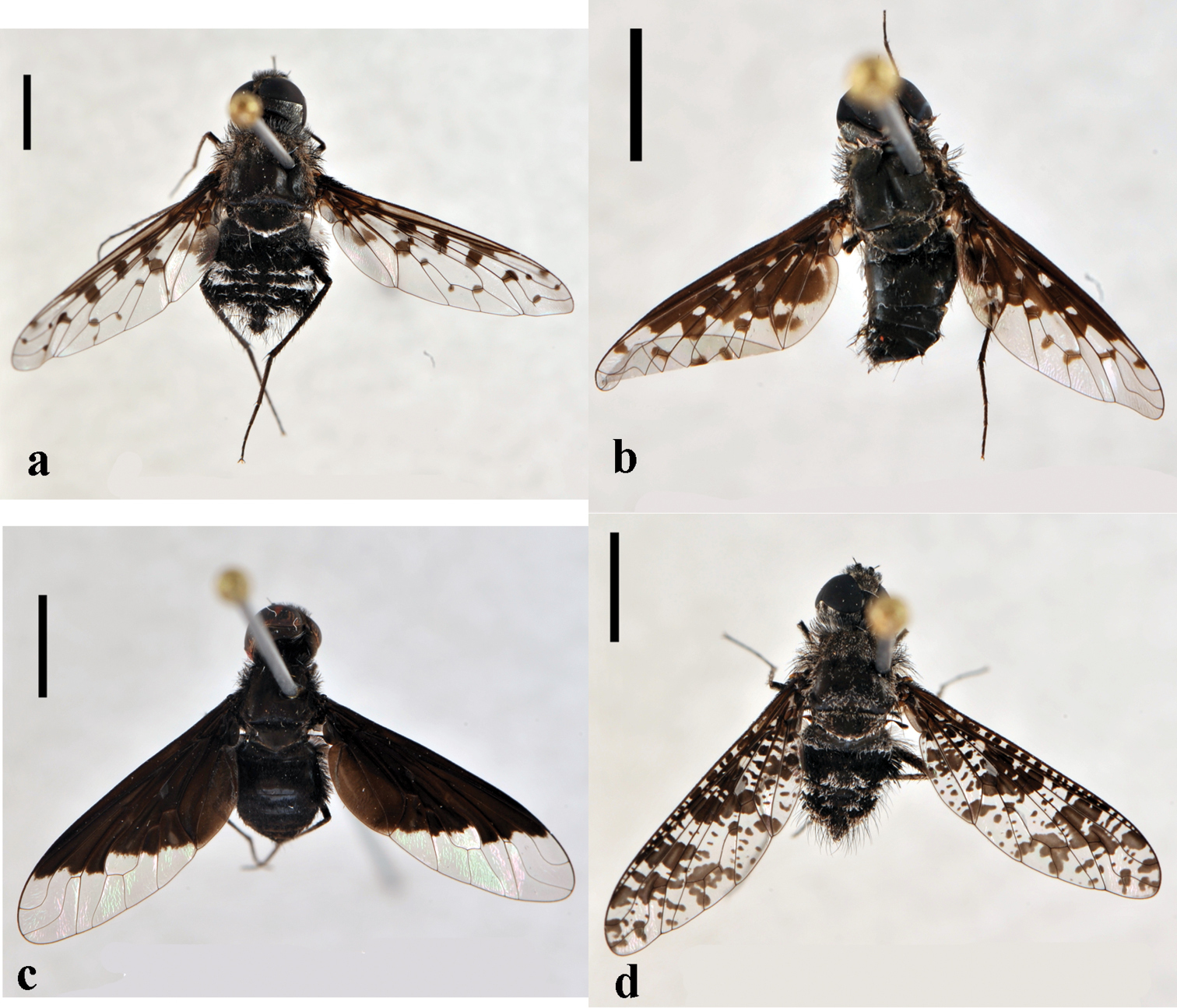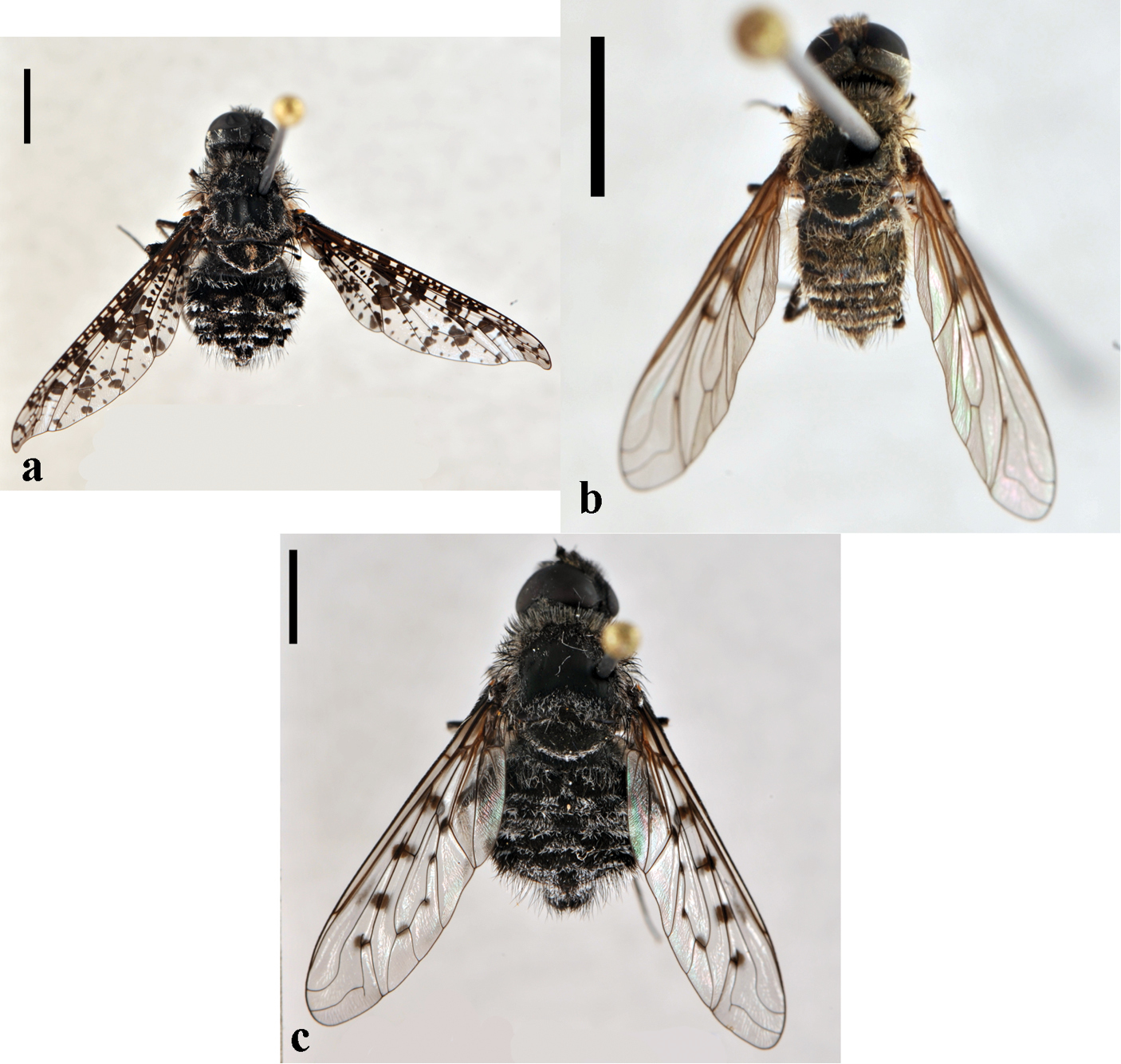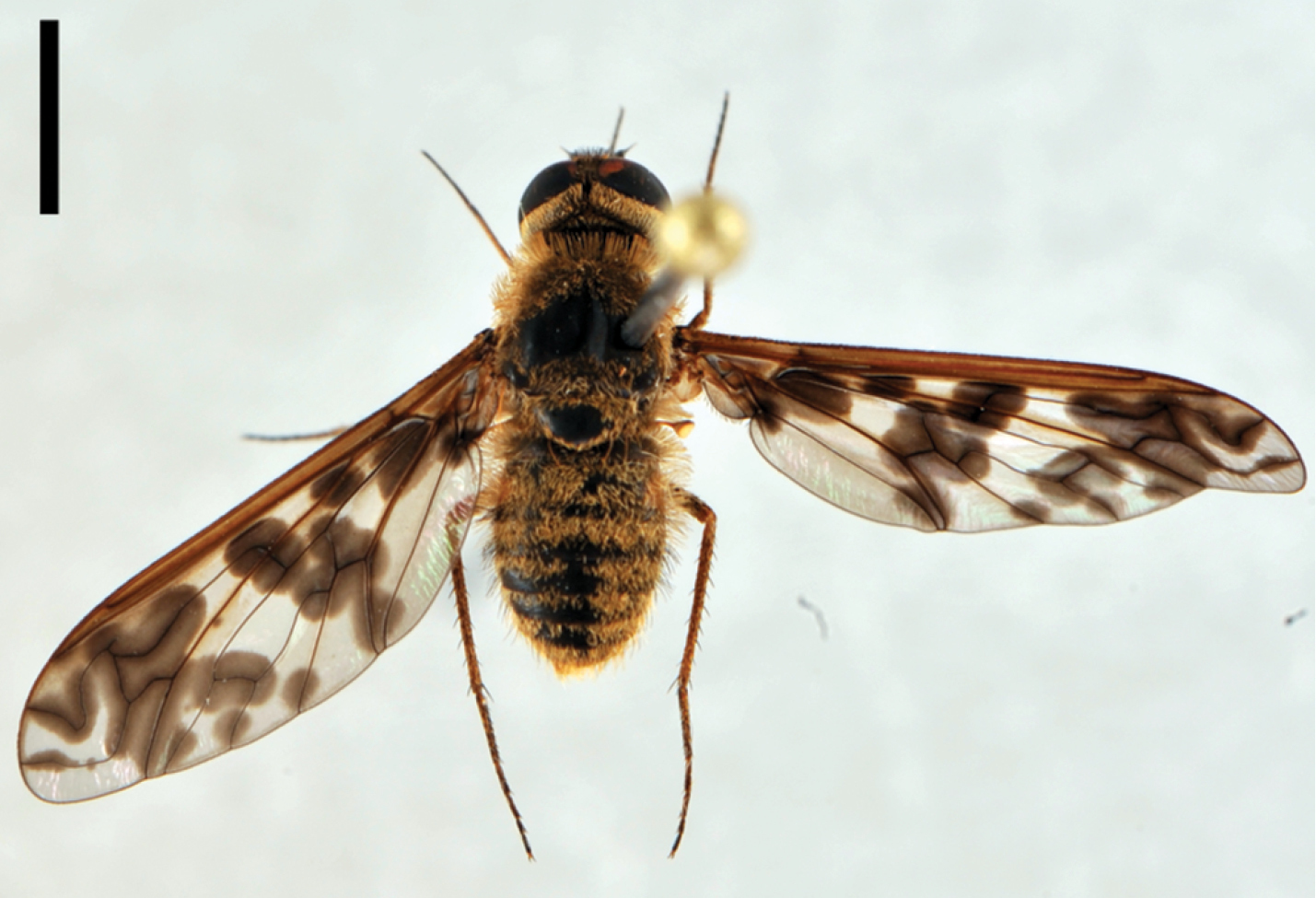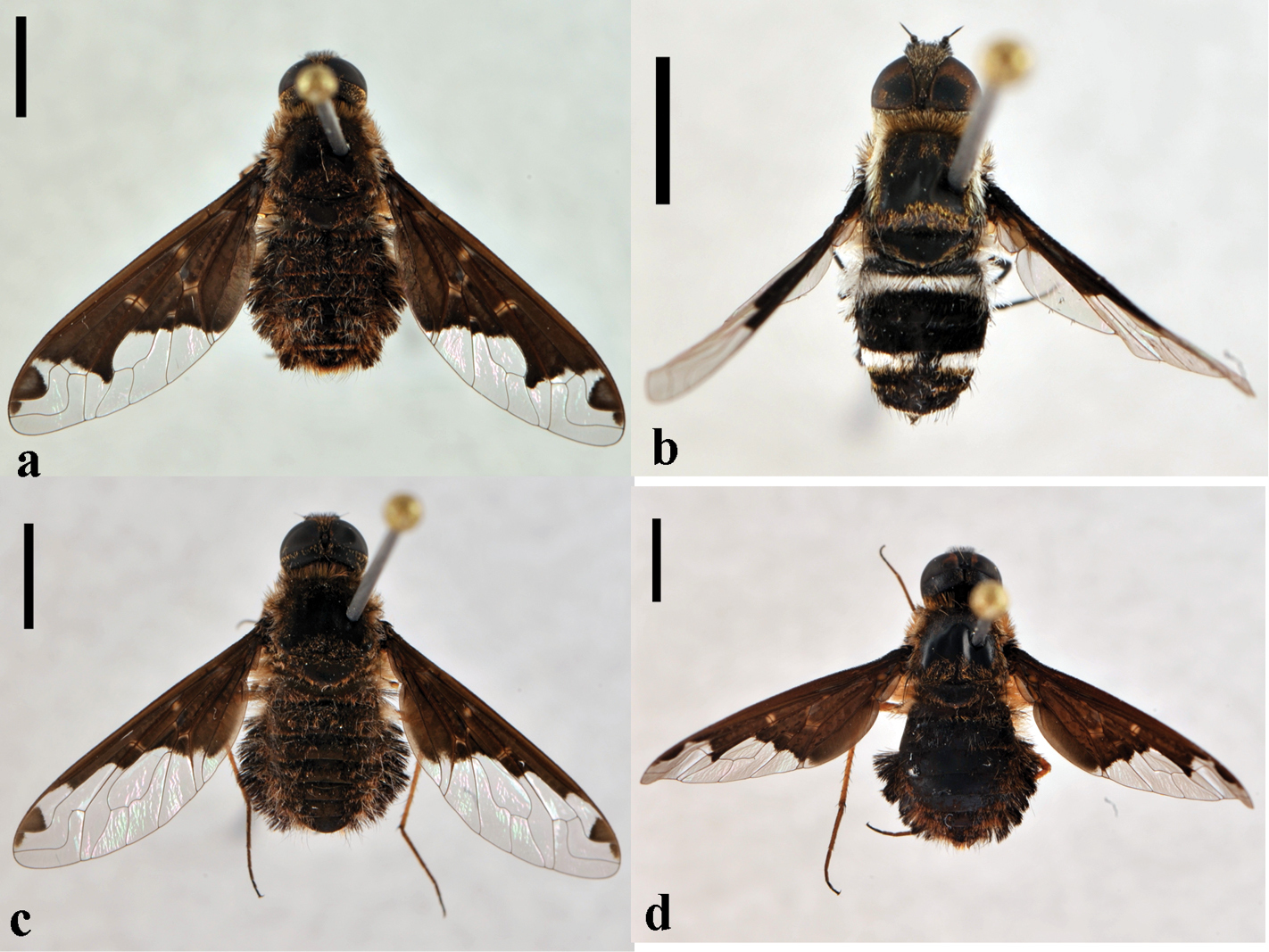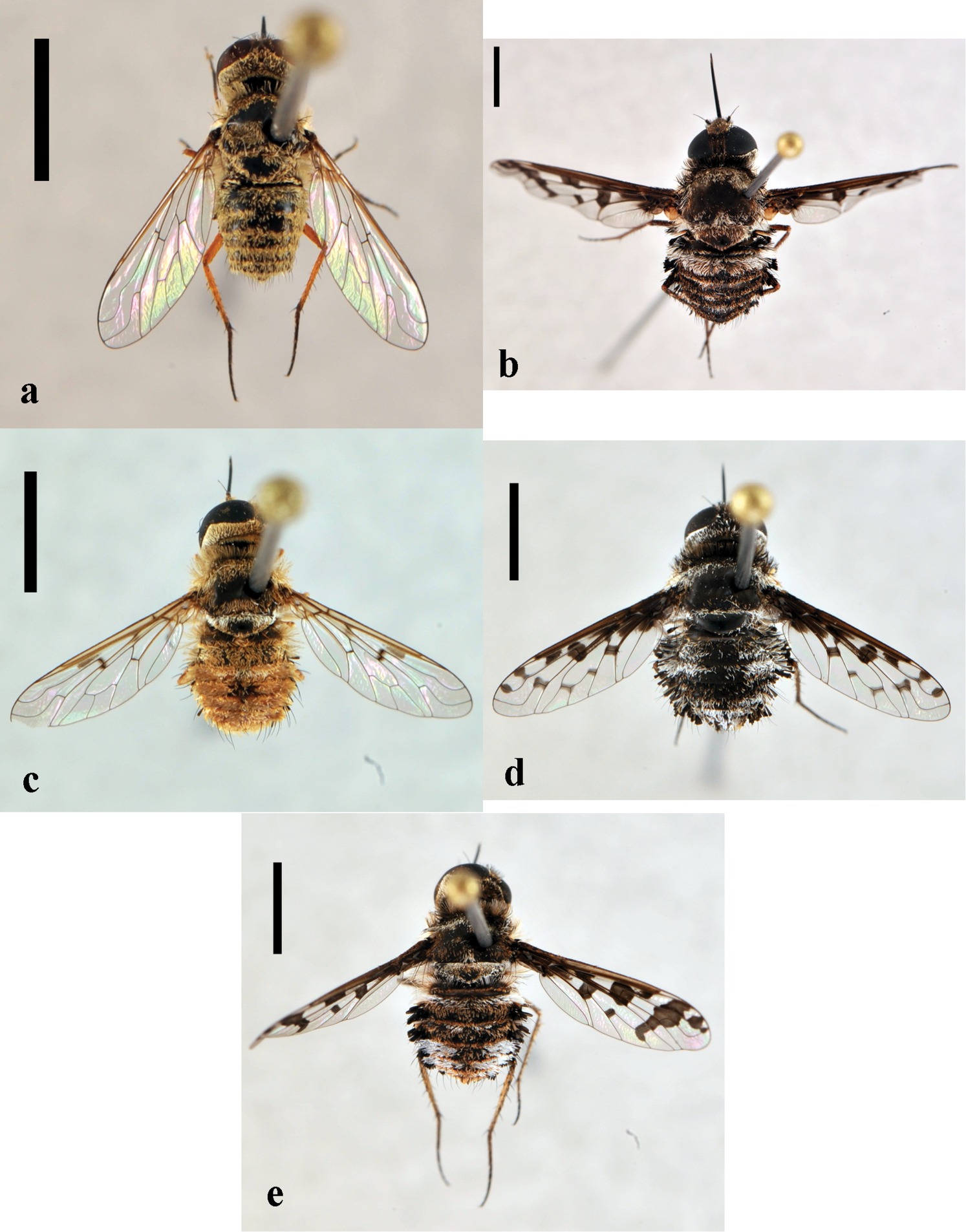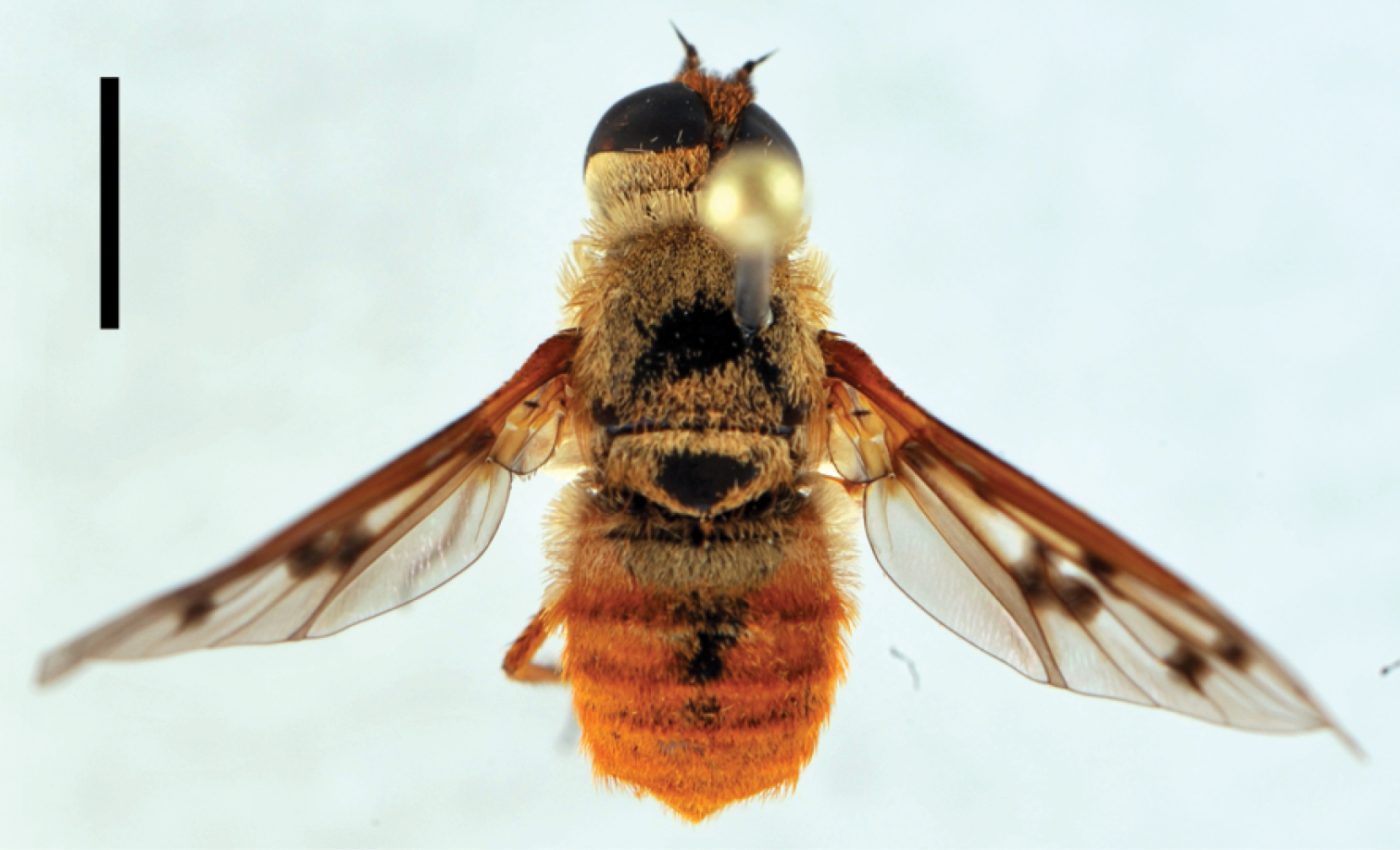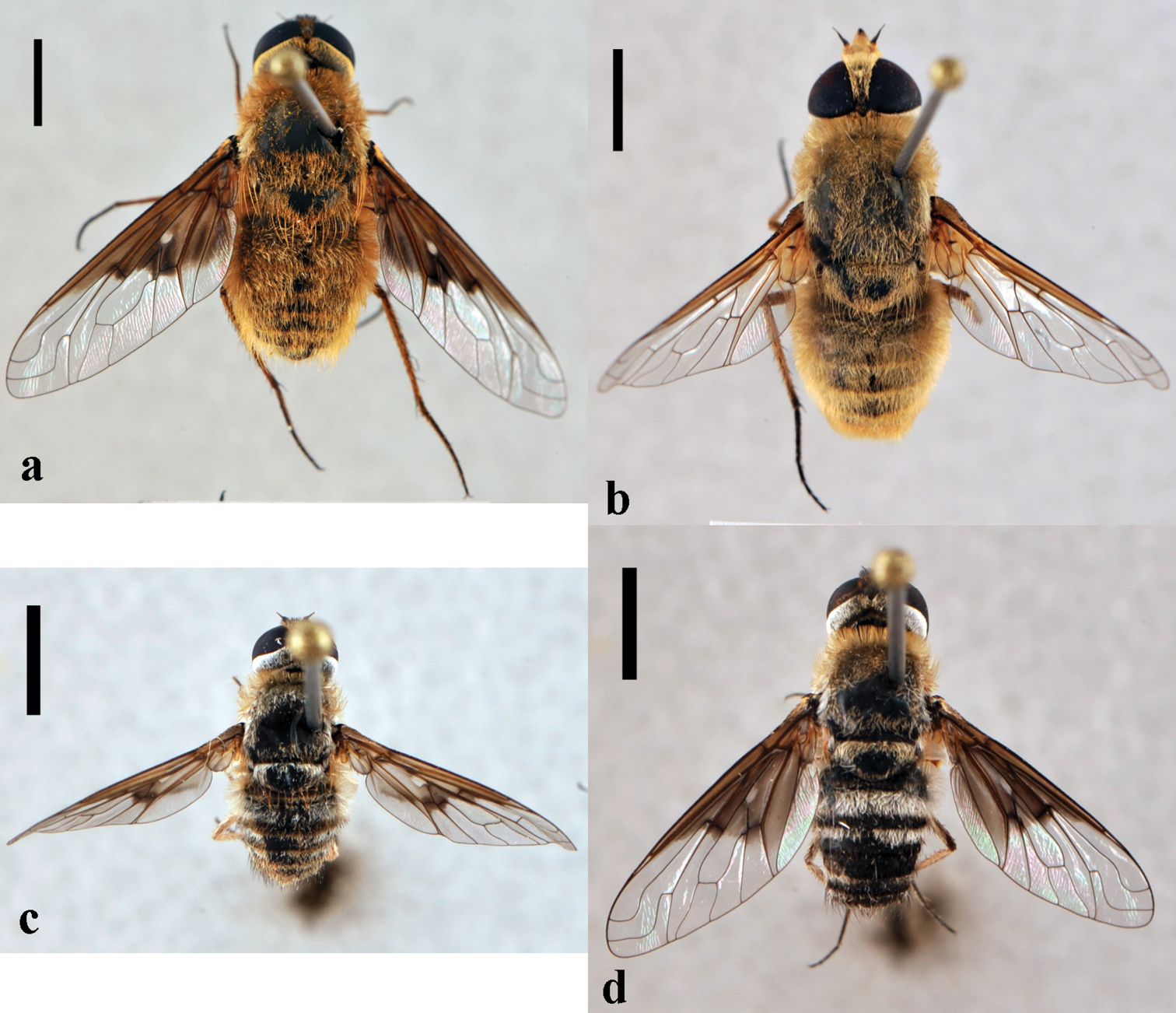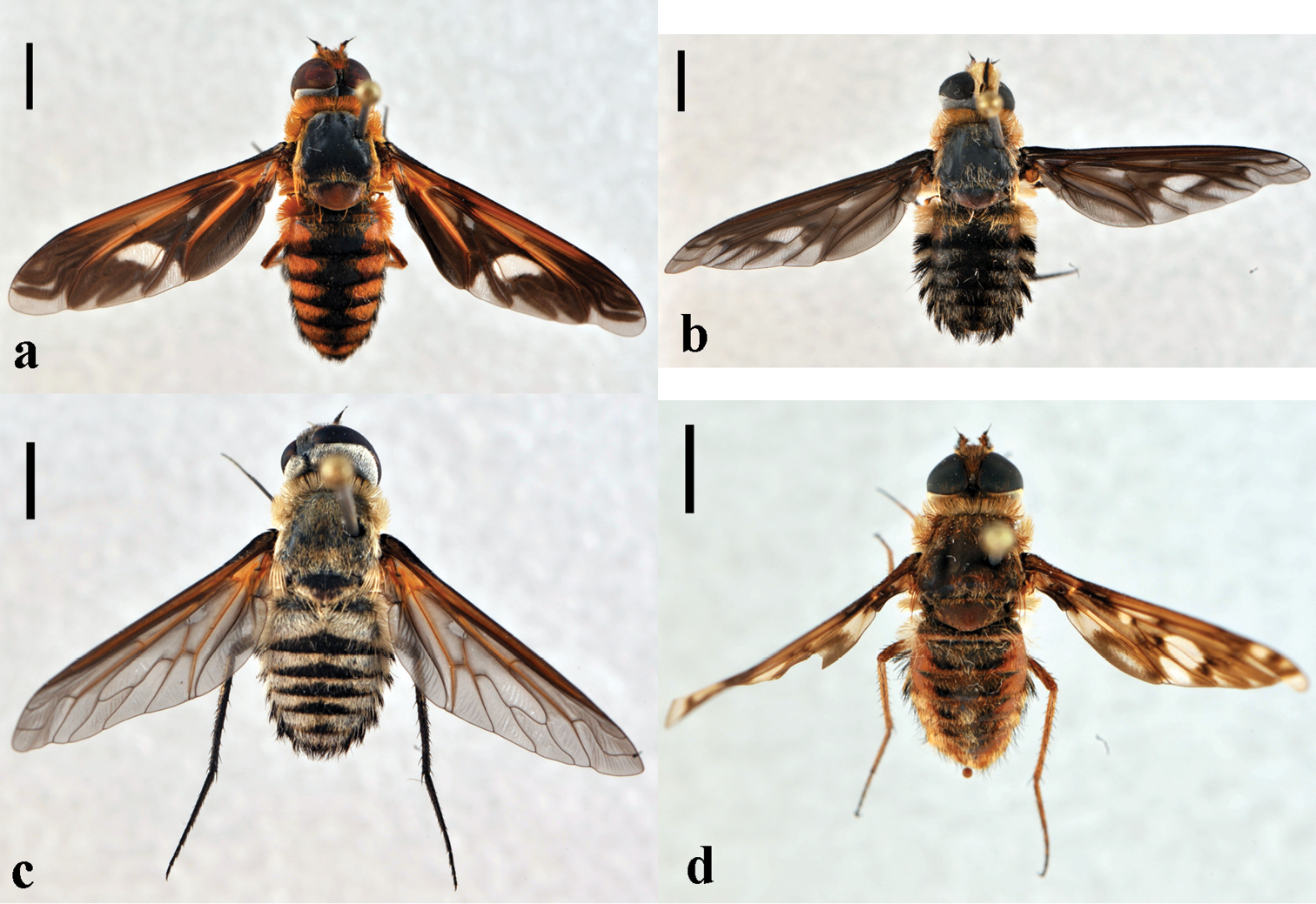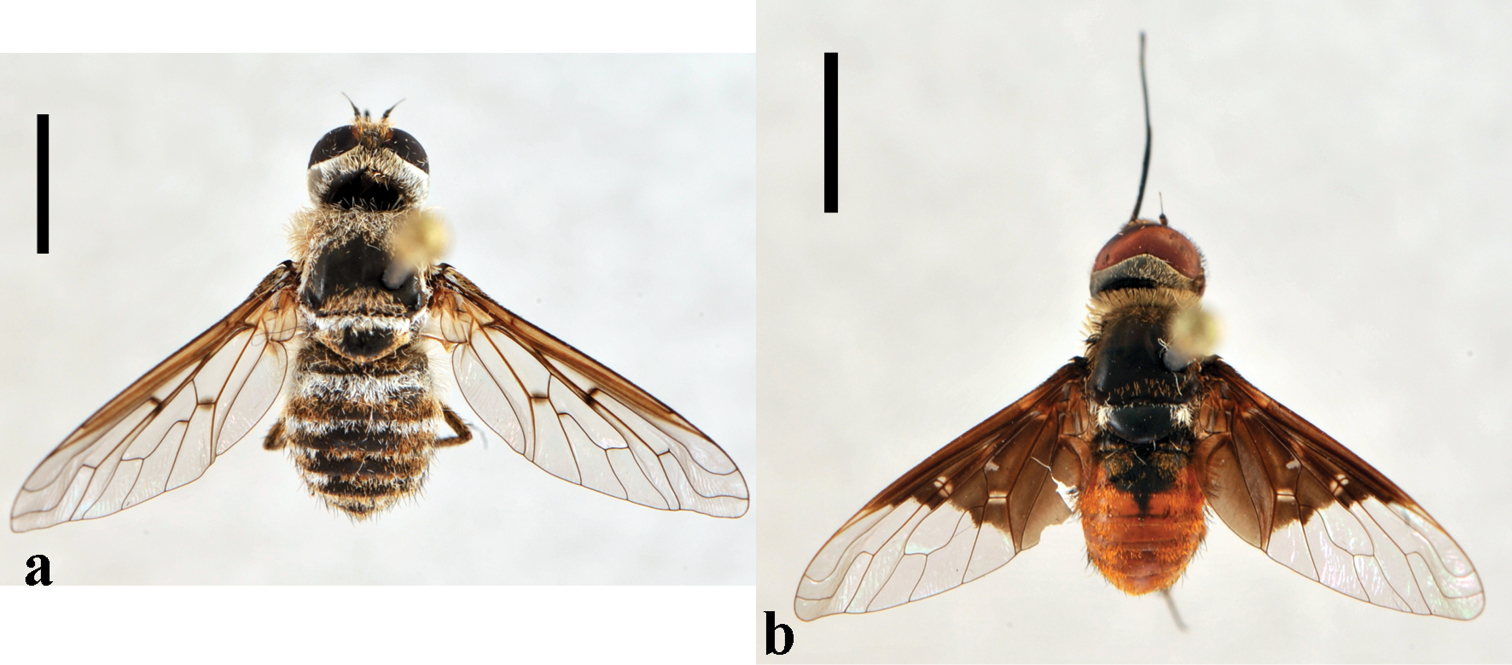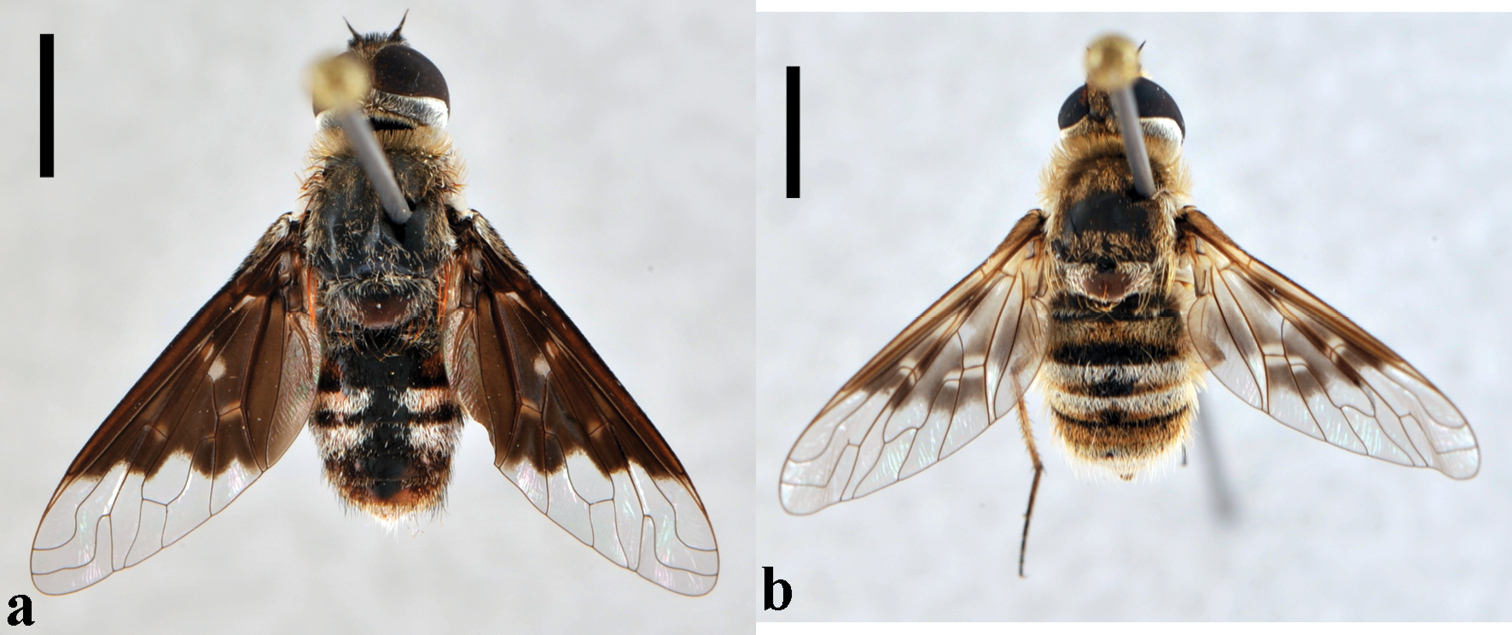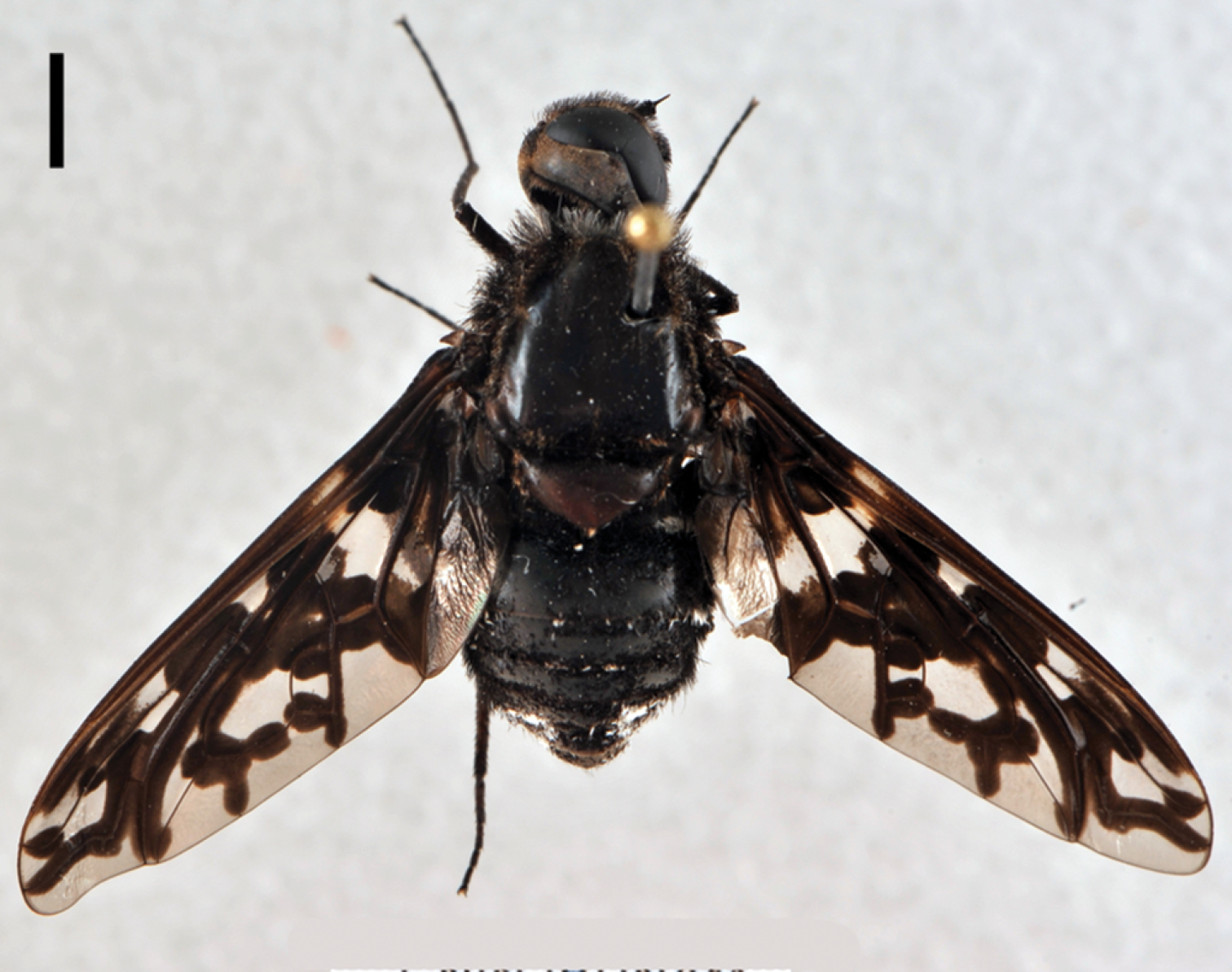






Citation: Ávalos-Hernández O, Kits J, Trujano-Ortega M, García-Vázquez UO, Cano-Santana Z (2014) New records of bee flies (Diptera, Bombyliidae) from Cuatro Ciénegas, Coahuila, Mexico. ZooKeys 422: 49–85. doi: 10.3897/zookeys.422.7598
Forty one new records of species of Bombyliidae are reported for Coahuila in northeastern Mexico. Nine of these species are reported for the first time for the country. The specimens were collected in the Cuatro Ciénegas Basin and Sierra La Madera mountains during 2007–2013. The modified distributions of species are discussed. The gaps in the distribution of many species suggest an undersampling of this group of insects in the north of Mexico.
Biodiversity, distribution expansion, Nearctic region, desert fauna
The bee flies (Bombyliidae) belong to the superfamily Asiloidea and are the eighth most diverse family within Diptera with 5382 described species (
Some faunistic studies have been completed including Bombyliidae in Mexico (
Cuatro Ciénegas Basin in the northeast of Coahuila is especially interesting because of its geological history and the presence of water ponds and gypsum dunes, which create a different environment from the surrounding areas. The basin was a shallow sea from the Pangea breakup until the Eocene, 40 Ma, when the Sierra Madre Oriental in the east of Mexico rose isolating the Basin from the Atlantic Ocean (
The present study is the first known long-term systematic sampling of Diptera in Cuatro Ciénegas. The objective of this project is to complete the list of species of Bombyliidae in the basin and surrounding mountains. In this paper, 41 new species-level records for Coahuila from Cuatro Ciénegas are presented, including nine new records for Mexico. The modified distributions of the species are discussed.
Beeflies were collected at nine sites from Cuatro Ciénegas Basin and Sierra La Madera within the Municipality of Cuatrociénegas (Figure 1). Abbreviations for study sites (Table 1) are used throughout. Samplings were performed during 2007-2013, using aerial net and a Malaise trap. The Malaise trap had white polyester netting, was square in configuration, 210 cm tall and 120 cm wide and the collecting head located at the top. Trap was set from 9:00 to 17:00 when weather conditions allowed it. To avoid damage to the specimens no killing agent was used, insects were extracted at the end of the day. Specimens were pinned and labeled. Generic identification was carried out under a stereomicroscope according to the keys by
Field work sites. Cuatro Ciénegas basin is located in Coahuila at northeast of Mexico. Sierra La Madera is located at northwest of the basin.
Field work sites in Cuatro Ciénegas. Vegetation according to
| Site (Code) | Location | Altitude (m) | Vegetation | |
|---|---|---|---|---|
| 1 | Churince (CHU) | 26°50'30"N, 102°08'10"W | 770 | Gypsum dunes; sedges and marshes; mezquital, halophile |
| 2 | Rancho Orozco (ROR) | 26°52'18"N, 102°05'17"W | 740 | Sedges and marshes; mezquital; halophile |
| 3 | Rancho Pozas Azules (RPA) | 26°49'39"N, 102°01'24"W | 710 | Sedges and marshes; mezquital; halophile |
| 4 | Ejido Antiguos Mineros (EAM) | 26°46'58"N, 102°00'20"W | 725 | Sedges and marshes; mezquital; halophile |
| 5 | El Cañón (ECA) | 27°00'34"N, 102°04'42"W | 780 | Mezquital; desert scrub |
| 6 | Ejido El Oso (EEO) | 27°03'08"N, 102°13'35"W | 1085 | Desert scrub; chaparral |
| 7 | Rancho El Espejo (REE) | 27°13'19"N, 102°30'19"W | 1425 | Desert scrub; chaparral |
| 8 | Rancho El Chupadero (REC) | 27°10'07"N, 102°34'26"W | 1790 | Desert scrub; chaparral; Pine-Oak forest |
| 9 | Rancho La Casita (RLC) | 27°06'45"N, 102°23'40"W | 1630 | Desert scrub; chaparral; Pine-Oak forest |
A total of 41 new species-level records are presented for the state of Coahuila. Nine of these 41 species are recorded for the first time in Mexico, being their most southern records. Of the 15 species previously listed for Coahuila, two were collected during this study: Heterostylum robustum (Osten Sacken, 1877) (Material collected: CHU: Apr (1 M), Sep (1 M); EAM: Mar (2 M), Sep (1 F), Jun (2 F), Jul (1 F), Oct (1 F); ROR: Apr (1 F, 3 M), May (1 F, 2 M), Jul (3 F), Sep (1 F); RPA: Apr (1 F, 1 M), Jul (2 F, 2 M), Sep (1 M), Oct (2 M)); and Anastoechus melanohalteralis Tucker, 1907 (Material collected: EAM: Oct (1 M); ECA: Oct (1 F, 1M); ROR: Oct (7 F, 6 M); RPA: Sep (1 M)).
New records of the species included in this paper are from 17 genera for which modern revisions are available. Six taxa of Hemipenthes (3), Lordotus (1), Paravilla (1) and Rhynchanthrax (1) could not be identified accurately, being probably undescribed species. Identification of species in another 10 genera found in the study (e.g. Villa, Chrysanthrax, and Exoprosopa) is difficult and unreliable. The number of morphospecies and specimens collected of these genera are presented in Table 2. Six species of Tmemophlebia (1), Geron (1), Exoprosopa (3) and Villa (1) previously listed for Coahuila were probably collected but specimens of these genera are still being identified. Taxonomic work will continue, updates of the species list and descriptions of the new taxa will be published in subsequent papers.
Updated list of genera and species of Bombyliidae in Coahuila (* species not collected in this study, but recorded previously in Coahuila; ** species most likely collected in this study, but identification not yet certain).
| Subfamily, genus and species name | New record | Unidentifiable material |
|---|---|---|
| PHTHRIINAE | ||
| Neacreotrichus Cockerell | ||
| * Neacreotrichus consors (Osten Sacken, 1887) | ||
| Poecilognathus Jaennicke | Coahuila | 1 morphospecies, 3 specimens |
| Relictiphthiria Evenhuis | ||
| * Relictiphthiria psi (Cresson, 1919) | ||
| Tmemophlebia Evenhuis | 1 morphospecies, 21 specimens | |
| ** Tmemophlebia coquilletti (Johnson, 1902) | ||
| TOXOPHORINAE | ||
| Geron Meigen | 2 morphospecies, 194 specimens | |
| ** Geron holosericeus Walker, 1849 | ||
| Systropus Wiedemann | Coahuila | 1 morphospecies, 5 specimens |
| Toxophora Meigen | Coahuila | |
| Toxophora maxima Coquillett, 1886 | Coahuila | |
| Toxophora virgata Osten Sacken, 1877 | Coahuila | |
| BOMBYLIINAE | ||
| Anastoechus Osten Sacken | ||
| Anastoechus melanohalteralis Tucker, 1907 | ||
| Bombylius Linnaeus | ||
| Bombylius (Bombylius) frommerorum Hall & Evenhuis, 1980 | Coahuila | |
| * Bombylius (Bombylius) sylphae Evenhuis, 1984 | ||
| * Bombylius (Parabombylius) aleophilus (Hall & Evenhuis, 1981) | ||
| * Bombylius (Parabombylius) coahuilensis (Hall & Evenhuis, 1981) | ||
| * Bombylius (Parabombylius) paradoxus (Hall & Evenhuis, 1981) | ||
| * Bombylius (Parabombylius) syndesmus (Coquillett, 1894) | ||
| Conophorus Meigen | Coahuila | 1 morphospecies, 3 specimens |
| Heterostylum Macquart | ||
| Heterostylum croceum Painter, 1930 | Mexico | |
| Heterostylum robustum (Osten Sacken, 1877) | ||
| Lordotus Loew | Coahuila | 1 morphospecies, 38 specimens |
| Lordotus diplasus Hall, 1954 | Coahuila | |
| Lordotus divisus Cresson, 1919 | Coahuila | |
| Lordotus perplexus Johnson & Johnson, 1959 | Coahuila | |
| Triploechus Edwards | Coahuila | |
| Triploechus novus (Williston, 1893) | Coahuila | |
| LOMATIINAE | ||
| Ogcodocera Macquart | Coahuila | |
| Ogcodocera analis Williston, 1901 | Coahuila | |
| TOMOMYZINAE | ||
| Paracosmus Osten Sacken | Coahuila | |
| Paracosmus (Paracosmus) morrisoni Osten Sacken, 1887 | Coahuila | |
| ANTHRACINAE | ||
| Anthrax Scopoli | Coahuila | |
| Anthrax atriplex Marston, 1970 | Coahuila | |
| Anthrax cybele (Coquillett, 1894) | Mexico | |
| Anthrax georgicus Macquart, 1834 | Coahuila | |
| Anthrax irroratus Say, 1823 | Coahuila | |
| Anthrax oedipus Fabricius, 1805 | Coahuila | |
| Anthrax pauper (Loew, 1869) | Mexico | |
| Anthrax seriepunctatus (Osten Sacken, 1886b) | Coahuila | |
| Aphoebantus Loew | Coahuila | 4 morphospecies, 236 specimens |
| Chrysanthrax Osten Sacken | Coahuila | 6 morphospecies, 240 specimens |
| Dipalta Osten Sacken | Coahuila | |
| Dipalta serpentina (Osten Sacken, 1877) | Coahuila | |
| Exoprosopa Macquart | 9 morphospecies, 395 specimens | |
| ** Exoprosopa aztec Painter & Painter, 1969 | ||
| ** Exoprosopa butleri Johnson & Johnson, 1958 | ||
| ** Exoprosopa dorcadion Osten Sacken, 1877 | ||
| Hemipenthes Loew | Coahuila | 3 morphospecies, 146 specimens |
| Hemipenthes jaennickeana (Osten Sacken, 1886a) | Coahuila | |
| Hemipenthes lepidota (Osten Sacken, 1886b) | Coahuila | |
| Hemipenthes scylla (Osten Sacken, 1887) | Coahuila | |
| Hemipenthes sinuosa (Wiedemann, 1821) | Coahuila | |
| Lepidanthrax Osten Sacken | Coahuila | |
| Lepidanthrax arizonensis Hall, 1976 | Mexico | |
| Lepidanthrax disiunctus (Wiedemann, 1830) | Coahuila | |
| Lepidanthrax hesperus Hall, 1976 | Coahuila | |
| Lepidanthrax hyposcelus Hall, 1976 | Coahuila | |
| Lepidanthrax proboscideus (Loew, 1869) | Coahuila | |
| Ligyra Newman | Coahuila | 1 morphospecies, 2 specimens |
| Neodiplocampta Curran | Coahuila | |
| Neodiplocampta (Neodiplocampta) miranda Hull & Martin, 1974 | Coahuila | |
| Paravilla Painter | Coahuila | 1 morphospecies, 48 specimens |
| Paravilla edititoides (Painter, 1933) | Coahuila | |
| Paravilla flavipilosa (Cole, 1923) | Coahuila | |
| Paravilla parvula Hall, 1981a | Coahuila | |
| Paravilla separata (Walker, 1852) | Mexico | |
| Poecilanthrax Osten Sacken | Coahuila | |
| Poecilanthrax effrenus (Coquillett, 1887) | Coahuila | |
| Poecilanthrax fasciatus Johnson & Johnson, 1957 | Mexico | |
| Poecilanthrax hyalinipennis Painter & Hall, 1960 | Mexico | |
| Poecilanthrax poecilogaster (Osten Sacken, 1886b) | Coahuila | |
| Rhynchanthrax Painter | Coahuila | 1 morphospecies, 70 specimens |
| Rhynchanthrax capreus (Coquillett, 1887) | Mexico | |
| Rhynachantrax texanus (Painter, 1933) | Coahuila | |
| Thyridanthrax Osten Sacken | Coahuila | |
| Thyridanthrax pallidus (Coquillett, 1887) | Mexico | |
| Thyridanthrax selene (Osten Sacken, 1886b) | Coahuila | |
| Villa Lioy | 9 morphospecies, 115 specimens | |
| ** Villa fumicosta Painter & Painter, 1962 | ||
| Xenox Evenhuis | Coahuila | |
| Xenox xylocopae (Marston, 1970) | Coahuila | |
A total of 28 genera were found during this study, of which 21 are new records for the state. Two genera previously listed for Coahuila (Neacreotrichus and Relictiphthiria) were not found in Cuatro Ciénegas area. With the new records presented here, the list of bee fly species in Coahuila increases to 56 (Table 2).
Toxophora is distributed worldwide, being more diverse in the Afrotropical and Palearctic regions. Mexico's fauna includes three Neotropical species and five Nearctic species. All Nearctic species of Mexico were distributed in the western half of the country. These two new records represent the first of this genus in Coahuila and the most eastern distribution of the Nearctic species in the country. The New World species of this genus were keyed using
CHU: Jul (1 M); EEO: Jul (2 F, 2 M), Oct (1 F, 3 M).
Mexico (Baja California, Baja California Sur, Coahuila); USA (Arizona, California, Idaho, Kansas, New Mexico, Oklahoma, Oregon, Texas).
In Mexico Toxophora maxima was only known from Baja California Peninsula and now Coahuila. This apparent gap in its distribution is probably due to undersampling. Sampling of the intermediate zones is necessary to know if these populations form a continuous unit as they do in the southern states of USA.
Toxophora. Toxophora maxima, male (CNIN 1115) a dorsal view b lateral view; Toxophora virgata, male (CNIN 1109) c lateral view d posterior view. All scale bars: 3 mm.
EAM: Jun (1 F, 1 M), Jul (1 F); CHU: Aug (1 M), Oct (1 M); EEO: Jul (1 M), Oct (1 F, 1 M); RLC: Jun (1 M); ROR: Apr (1 F, 2 M); RPA: Oct (1 F).
Mexico (Baja California Sur, Coahuila, Sonora); USA (Arizona, California, Colorado, Georgia, Idaho, Nevada, New Mexico, Oklahoma, Texas, Utah).
Odynerus sp. (Vespidae); Stenodynerus toltecus Saussure (Vespidae).
This species is present in the all southwestern states of the USA and northwest of Mexico. This is the first record in the northeast of Mexico. The species is probably also present in Chihuahua, between Sonora and Coahuila.
With 278 described species, Bombylius is the second most diverse genus of Bombyliidae. It has a worldwide distribution being especially diverse in the Palearctic and Nearctic regions. One endemic species is present in Coahuila: Bombylius (Parabombylius) coahuilensis (Hall & Evenhuis, 1981). Four other species are reported for the state: Bombylius sylphae Evenhuis, 1984, Bombylius aleophilus (Hall & Evenhuis, 1981), Bombylius paradoxus (Hall & Evenhuis, 1981), Bombylius syndesmus (Coquillett, 1894). A review with identification keys for Nearctic species is presented in
EEO: Aug (1 M), Oct (1 F).
Mexico (Chihuahua, Coahuila); USA (Arizona, New Mexico, Texas).
The genus is only present in Nearctic and Neotropical regions. Although not as diverse as other genera (only 12 species), specimens from some species are abundant in the field. Heterostylum robustum was previously known from Coahuila and was collected during this study. This species is distributed from Canada to central Mexico. There are two revisions for this genus that contains identification keys, one by
REE: Apr (1 F).
Mexico (Coahuila); USA (Colorado, Kansas, Missouri, New Mexico, Texas).
Heterostylum croceum is recorded for the first time in Mexico; previously known from the southern-central United States.
Heterostylum croceum, female (CNIN 858) a dorsal view b lateral view. All scale bars: 3 mm.
Most of the 29 species in this exclusively Nearctic genus are distributed in the southwest of the USA and north of Mexico, although eight species are present in the northwest of the USA (Lordotus apicula Coquillet, 1887; Lordotus bipartitus Painter, 1940; Lordotus diversus Coquillett, 1891; Lordotus gibbus Loew, 1863; Lordotus miscellus Coquillett, 1887; Lordotus pulchrissimus Williston, 1893; Lordotus striatus Painter, 1940; Lordotus zona Coquillett, 1887). The three species present in Coahuila are also found in California; their distribution probably includes all northern states of Mexico.
CHU: Sep (2 M); RLC: Sep (2 M); RPA: Sep (1 F).
Mexico (Coahuila, Zacatecas); USA (Arizona, California, New Mexico).
Lordotus. Lordotus diplasus, a female (CNIN 774) dorsal view b male (CNIN 861) dorsal view c Lordotus divisus, male (CNIN 777) dorsal view; Lordotus perplexus, female (CNIN 801) d dorsal view e lateral view. All scale bars: 3 mm.
ECA: Mar (1 M), Apr (2 M); EEO: Apr (16 M); REE: Apr (4 M); ROR: Apr (1 M).
Mexico (Coahuila, Baja California); USA (Arizona, California, Nevada, New Mexico, Texas).
CHU: Apr (1 H), ECA: Apr (1 H); EEO: Apr (4 F); REE: Apr (7 F); ROR: Apr (1 F).
Mexico (Baja California, Coahuila, Sinaloa, Sonora); USA (Arizona, California, Nevada, Texas).
Lordotus perplexus has the most southern distribution in the genus, reaching Sinaloa on the Pacific coast.
Four species of Triploechus are present in Nearctic region: Triploechus luridus Hall, 1975; Triploechus novus (Williston, 1893); Triploechus sackeni (Bigot, 1892); Triploechus stagei Hall, 1975. Of these Triploechus stagei is endemic to Mexico and Triploechus novus has the widest distribution of this genus, being present in the south of the USA and center of Mexico.
CHU: Apr (7 F, 6 M); REE: Apr (1 M); RPA: Apr (1 M).
Mexico (Coahuila, Durango, San Luis Potosí, Sonora); USA (Arizona, California, Nevada, New Mexico, Texas).
The only two species in this genus have been collected from the neotropical part of Mexico to north of the USA and Canada. Ogcodocera leucoprocta (Wiedemann, 1828), not sampled during this study, is present in the whole Nearctic region from Canada to south of Mexico.
EEO: Aug (2 M), Oct (1 M).
Mexico (Coahuila, Guerrero, Morelos); USA (Arizona, Texas).
This record is the first of this species in the north of Mexico, but it has been previously collected in the south of Mexico and in the south of USA, and thus is probably distributed across the whole country. Unlike Ogcodocera leucoprocta, Ogcodocera analis has its most northern distribution in Arizona and Texas.
Ogcodocera analis, male (CNIN 146) dorsal view. Scale bar: 3 mm.
All five extant species of Paracosmus have Nearctic distributions, and all are present in California. Two of these species have been collected in the northwest of Mexico (Paracosmus (Actherosia) rubicundus Melander, 1950 and Paracosmus (Paracosmus) morrisoni Osten Sacken, 1887).
EAM: Apr (1 F, 1 M); CHU: Apr (2 M), Jul (1 F), Aug (2 F); ECA: Apr (1 M); EEO: May (1 F); REE: Apr (1 F); ROR: Apr (2 M), May (1 F, 3 M); RPA: Apr (1 F).
Mexico (Coahuila, Sonora); USA (Arizona, California, Nevada, Texas).
Paracosmus (Paracosmus) morrisoni has the widest distribution within this genus, but in Mexico had previously only been recorded in Sonora. This record represent the most eastern distribution for the genus in the country.
Paracosmus (Paracosmus) morrisoni, male (CNIN 832) a dorsal view b lateral view. All scale bars: 3 mm.
This is a diverse genus with 248 species worldwide. Two old but complete revisions of the genus, including distribution maps and keys, were made by
EAM Apr (1 F); ROR: Oct (2 M); RPA: Aug (1 M); Sep (1 M); Oct (1 F, 2 M).
Mexico (Baja California Sur, Coahuila, Durango, Sonora, Tamaulipas); USA (Arizona, California, New Mexico, Oregon, Texas, Utah).
Megachile gentilis Cresson (Megachilidae).
This species may be present in all the north of Mexico, including Chihuahua, Nuevo León and possibly Sinaloa.
Anthrax part I. a Anthrax atriplex, male (CNIN 1098) dorsal view b Anthrax cybele, male (CNIN 1087) dorsal view c Anthrax georgicus, female (CNIN 1071) dorsal view d Anthrax irroratus, male (CNIN 1027) dorsal view. All scale bars: 3 mm.
ECA: Apr (2 F); EEO: Apr (1 M).
Mexico (Coahuila); USA (Arizona, California).
This is a rare species flying in April. Its distribution is disjunct so far, present in the southwest of the USA and northeast of Mexico. It is probably also found in New Mexico and Texas in the USA and Sonora and Chihuahua in Mexico.
EAM: Mar (1 F), Apr (1 M), Jun (1 F, 2 M), Jul (2 F), Sep (2 M); ROR: Apr (1 F), Sep (1 M); RPA: Mar (1 M), Apr (1 F, 1 M), Jul (2 F, 1 M), Sep (6 F, 3 M), Oct (6 F, 3 M).
Canada (Alberta, British Columbia, Manitoba, Northwest Territory, Ontario, Quebec, Saskatchewan); Mexico (Coahuila, Guerrero, Michoacán de Ocampo, Morelos, Nuevo León, Puebla, Sonora, Veracruz); USA (Arizona, Arkansas, California, Colorado, Connecticut, Delaware, District of Columbia, Florida, Georgia, Idaho, Illinois, Iowa, Kansas, Kentucky, Maryland, Massachusetts, Michigan, Minnesota, Missouri, Montana, Nebraska, Nevada, New Hampshire, New Jersey, New Mexico, New York, North Carolina, Ohio, Oklahoma, Oregon, Pennsylvania, Tennessee, Texas, Utah, Vermont, Virginia, Washington, West Virginia, Wisconsin, Wyoming).
The range of Anthrax georgicus includes all North America and Central America (Nicaragua, Costa Rica) covering a wide diversity of habitats and environmental conditions. Common in the rainy season and present in the dry season (March), this species is probably present in most if not all states of Mexico, but has only been collected in eight of them.
EAM: Apr (1 M), Aug (2 M), Oct (1 M); ECA: Apr (1 F), May (1 F, 1 M); EEO: Apr (2 F), Jul (4 F), Aug (1 M); REC: Apr (3 F, 10 M), Aug (1 M); REE: Aug (1 M); RLC: Jul (6 F, 10 M); ROR: Feb (1 M), Aug (5 M), Sep (1 M); RPA: Apr (1 M), Aug (2 M).
Canada (Alberta, British Columbia, Manitoba, Northwest Territory, Nova Scotia, Ontario, Quebec, Saskatchewan); Mexico (Baja California, Baja California Sur, Coahuila, Colima, Guerrero, Michoacán, Morelos, Nayarit, Puebla, San Luis Potosí, Sinaloa, Sonora, Veracruz, Zacatecas); USA (Alaska, Arizona, Arkansas, California, Colorado, Connecticut, Idaho, Illinois, Indiana, Kansas, Maryland, Massachusetts, Michigan, Missouri, Montana, Nebraska, Nevada, New Hampshire, New Jersey, New Mexico, New York, Oregon, Pennsylvania, Tennessee, Texas, Utah, Virginia, West Virginia, Wyoming).
Megachile gentilis Cresson (Megachilidae); Megachile mendica Cresson (Megachilidae); Dianthidium heterulkei fraternum Timberlake (Megachilidae); Aschmendiella bucconis denticulata Cresson (Megachilidae); Hylaeus asininus Cockrell and Casad (Colletidae).
Anthrax irroratus, like Anthrax georgicus (above), is present in all of North America and reaches Central America and Caribbean islands (Honduras, Puerto Rico). More abundant than its congener, this species has been collected in 15 states in Mexico (including Oaxaca of the Neotropical region not listed above) and all regions of the USA. Anthrax irroratus should be collected in any systematic, long term Bombyliidae sample in Mexico and the USA.
ECA: Apr (1 F, 1 M), Jul (1 F); EEO: Apr (2 F, 1 M), May (1 F, 4 M), Jul (1 M); REC: Apr (1 F); REE: Apr (2 M); RLC: Jul (2 F, 4 M), Sep (1 F); RPA: Apr (1 M), Aug (1 M).
Mexico (Baja California, Coahuila, Nayarit, Morelos, Sinaloa, Sonora); USA (Nevada, Texas).
Apparently closely related to Anthrax irroratus, Anthrax oedipus has a narrow distribution in the Nearctic region but is widely distributed in all South America. In the USA it has been collected only in two southern states, while it occurs in most of the northern states of Mexico and one central state (Morelos); it may be present in most areas from Texas to Argentina.
Anthrax part II. a Anthrax oedipus, female (CNIN 1055) dorsal view b Anthrax pauper, female (CNIN 1085) dorsal view c Anthrax seriepunctatus, female (CNIN 1089) dorsal view. All scale bars: 3 mm.
CHU: Apr (1 F, 1 M).
Canada (Ontario); Mexico (Coahuila); USA (Alabama, Colorado, Illinois, Indiana, Kansas, Maryland, Massachusetts, Michigan, Nebraska, New Jersey, New Mexico, New York, Oklahoma, Pennsylvania, Texas, Utah, Vermont, Virginia, Wisconsin).
With just two specimens collected, Anthrax pauper appears to be a rare species in this region. This population is the most southern recorded of this species, mostly present in the center and east of the USA. Presumably adapted to colder climates, it is no coincidence that it was collected in the most elevated site sampled.
EAM: Jun (1 M); CHU: Apr (1 F), Aug (1 F), Sep (1 F); ECA: Jun (1 M); REE: Aug (1 F); RLC: Jun (1 F), Jul (1 F, 2 M).
Mexico (Baja California Sur, Coahuila, Sonora, Puebla); USA (Arizona, Nevada, New Mexico, Texas).
This species is recorded mostly from the south of the USA and north of Mexico, but its presence in Puebla in central Mexico suggests a wider distribution within the country, at least in all northern states.
Dipalta is a small genus with just two species. Dipalta banksi Johnson, 1921 is only present in eastern Canada and USA, while Dipalta serpentina is distributed from Central America to the northern USA.
REC: Aug (1 M); RLC: Jul (1 M).
Mexico (Coahuila, Guerrero, Hidalgo, México, Morelos, Puebla, San Luis Potosí, Sinaloa); USA (Arizona, Arkansas, California, Colorado, Florida, Georgia, Idaho, Illinois, Indiana, Iowa, Kansas, Kentucky, Maine, Maryland, Massachusetts, Michigan, Minnesota, Missouri, Montana, Nebraska, Nevada, New Mexico, North Carolina, North Dakota, Ohio, Oklahoma, Oregon, South Dakota, Tennessee, Texas, Utah, Washington, Wisconsin, Wyoming).
Myrmeleon immaculatus De Geer (Myrmeleontidae).
Hemipenthes is equally diverse in the Nearctic (29 species), Neotropical (26 species) and Palearctic (37 species) regions, with just six species in the Oriental region and one in the Afrotropical region. Four species of this genus were collected in Coahuila. All of these have broad distributions but apparently from poor sampling because records are not continuous, especially in Mexico.
REC: Apr (18 F), Aug (4 F); REE: Feb (3 F); RLC: Mar (7 F), Jul (23 F, 3 M), Sep (3 F).
Mexico (Coahuila, Morelos, Sonora); USA (Arizona, California, Colorado, Idaho, Montana, Nevada, New Mexico, Oregon, Texas, Utah).
Present mainly in the Pacific coast states of the USA and Mexico, from Oregon as far as Morelos in the center of Mexico. This record is the most eastern record in Mexico.
Hemipenthes. a Hemipenthes jaennickeana, female (CNIN 1137) dorsal view b Hemipenthes lepidota, female (CNIN 200) dorsal view c Hemipenthes scylla, male (CNIN 725) dorsal view d Hemipenthes sinuosa, female (CNIN 1134) dorsal view. All scale bars: 3 mm.
EAM: Apr (1 M), Aug (1 F); CHU: Apr (1 F, 3 M), Aug (1 M); EEO: Jul (1 F, 4 M), Aug (1 F); REC: (1 M); REE: Apr (11 F, 2 M), Aug (1 F); RLC: Jun (1 F), Jul (3 F); RPA: Apr (1 F), Sep (4 F), Oct (2 F).
Canada (Alberta); Mexico (Baja California, Baja California Sur, Coahuila, Chihuahua, Guerrero, Morelos, Puebla, San Luis Potosí, Sonora, Tamaulipas); USA (Arizona, California, Colorado, Idaho, Louisiana, Nevada).
This species is abundant in the rainy season in most of the Nearctic region but has not been collected in many states of Mexico or the USA where it probably is present.
REC: Apr (23 M), Aug (7 M); REE: Feb (5 M), Apr (2 M); RLC: Mar (8 M), Jul (8 M), Sep (9 M).
Mexico (Coahuila, Morelos, Guanajuato, Sonora); USA (Arizona, Texas).
Males of this species are abundant all year long but females are unknown. There is no explanation for this lack of females in the collections. Extreme sexual dimorphism and misidentification of females can be dismiss, since there is no Hemipenthes species from which only females are known. One possible explanation is that females life span is too short and therefor encounter probabilities are low. Distribution is discontinuous with populations present in central and northern Mexico and the southern USA; it is unknown whether this species is present in between these areas.
REC: Apr (3 F); REE: (Feb (1 F), Apr (2 F); RLC: Jul (1 F, 1 M), Sep (1 M); RPA: Sep (2 F).
Mexico (Coahuila, Morelos); USA (Alabama, Arizona, Arkansas, Connecticut, Delaware, Georgia, Illinois, Indiana, Iowa, Kansas, Kentucky, Louisiana, Maryland, Massachusetts, Minnesota, Mississippi, Missouri, Nebraska, New Jersey, New York, North Carolina, Ohio, Oklahoma, Pennsylvania, Rhode Island, South Carolina, South Dakota, Tennessee, Texas, Vermont, Virginia, West Virginia, Wisconsin).
Neodiprion sertifer Geoff. (Diprionidae).
Hemipenthes sinuosa is only known from Morelos in the center of Mexico and Coahuila in the northeast, but can be found almost in all of the USA. It is clearly undersampled in Mexico.
Forty seven of the 52 species of Lepidanthrax are from the Nearctic region.
EEO: Mar (1 F); Oct (2 M).
Mexico (Coahuila); USA (Arizona).
Lepidanthrax arizonensis has a restricted distribution, being present only in Arizona and Coahuila, but probably is also present in Chihuahua, Texas and New Mexico.
Lepidanthrax. a Lepidanthrax arizonensis, female (CNIN 1352) dorsal view b Lepidanthrax disiunctus female (CNIN 334) dorsal view c Lepidanthrax hesperus, male (CNIN 1339) dorsal view d Lepidanthrax hyposcelus, male (CNIN 369) dorsal view e Lepidanthrax proboscideus, male (CNIN 357) dorsal view. All scale bars: 3 mm.
REC: Aug (2 F, 1 M).
Mexico (Coahuila, Distrito Federal, Guerrero, Veracruz); USA (Arizona).
The distribution of Lepidanthrax disiunctus has its northern extreme in Arizona and its southern extreme in Oaxaca, in the southeast of Mexico. It seems this species is rarely collected, but widely distributed.
EAM: Apr (2 M); CHU: Apr (2 F, 5 M); ROR: Apr (1 F, 3 M), May (1 F, 1 M); RPA: Apr (1 F, 14 M).
Mexico (Baja California, Coahuila, Sinaloa, Sonora); USA (Arizona, California, New Mexico, Texas).
This record is the first in northeastern Mexico.
RLC: Sep (4 F, 15 M).
Mexico (Coahuila, Guerrero, Morelos, Puebla).
Lepidanthrax hyposcelus is endemic to Mexico, previously only known from the southwest of the country; this record extends its distribution to the northeast of the country.
ECA: Sep (1 F, 2 M); EEO: Apr (1 F), Aug (1 F, 1 M), Oct (4 F, 15 M); ROR: Sep (2 M); RPA: Sep (2 M), Oct (1 M).
Mexico (Baja California, Baja California Sur, Coahuila, Durango, Guerrero, Morelos, Sonora); USA (Arizona, California, Nevada, New Mexico, Utah).
Lepidanthrax proboscideus, Lepidanthrax fuscipennis Hall, 1976 and Lepidanthrax disiunctus are the only species of this genus distributed in both the Nearctic and Neotropical regions. Of these Lepidanthrax proboscideus extends as far as El Salvador, the most southern distribution for a Nearctic species of this genus. This is the first record of this species in the northeast of Mexico.
Neodiplocampta is a small American genus, more diverse in the Neotropical than the Nearctic region.
CHU: Aug (1 F); EEO: Aug (1 F, 1 M); ROR: Jul (1 F); Oct (1 M); RPA: Aug (1 F, 2 M).
Mexico (Coahuila, Guerrero, San Luis Potosi, Sinaloa, Sonora); USA (Arizona, California, Florida, Texas).
Neodiplocampta (Neodiplocampta) miranda and Neodiplocampta (Agitonia) sepia Hull, 1966 are the only two species distributed in both biogeographic regions (Nearctic and Neotropical). This species is distributed from the south of the USA to Nicaragua, but has not been collected in most Mexican states. This lack of records is possibly due its low abundance.
Neodiplocampta (Neodiplocampta) miranda, female (CNIN 225) dorsal view. Scale bar: 3 mm.
Fifty five of the 58 species of the genus are Nearctic. All species of Paravilla collected in Coahuila were exclusively collected in the summer months from April to July.
EAM: Jun (1 M); CHU: Apr (1 F), Jul (2 F, 1 M); ECA: Apr (1 F, 1 M), Jul (1 M); EEO: Apr (1 F, 10 M), May (1 F, 2 M), Jul (9 M); REE: Apr (1 M); RLC: Jun (2 F, 5 M), Jul (1 F); ROR: Jul (1 F, 3 M); RPA: Oct (1 M).
Canada (Saskatchewan); Mexico (Chihuahua, Coahuila, Durango, Jalisco, México, Zacatecas); USA (Arizona, Colorado, Idaho, Kansas, Montana, Nebraska, New Mexico, Oklahoma, Utah, Texas, Wyoming).
This species is very abundant and present in most of North America, from Canada as far as Jalisco in central Mexico.
Paravilla. a Paravilla edititoides, male (CNIN 1272) dorsal view b Paravilla flavipilosa, male (CNIN 1125) dorsal view c Paravilla parvula, female (CNIN 884) dorsal view d Paravilla separata, female (CNIN 898) dorsal view. All scale bars: 3 mm.
CHU: Apr (1 M); Jul (1 M); ECA: Apr (1 M); EEO: Apr (7 M), May (11 M); ROR: Apr (2 M); RPA: Apr (1 M).
Mexico (Baja California Sur, Coahuila, Nuevo León); USA (Arizona, California, Colorado, Texas).
Paravilla flavipilosa is abundant and restricted to the south of the USA and north of Mexico.
EAM: Apr (1 F); CHU: Apr (1 M); RPA: Apr (7 F, 13 M).
Mexico (Chihuahua, Coahuila, Durango, Guanajuato, Hidalgo, Jalisco, México, Michoacán, Nuevo León, San Luis Potosí, Sonora, Zacatecas), USA (Arizona, New Mexico, Texas, Utah).
Paravilla parvula is relatively well collected in northern and central Mexico. Its distribution also includes the south of the USA but no farther north than Utah.
CHU: Apr (1 F); EEO: Apr (3 F); REE: Apr (5 F, 3 M); RPA: Apr (1 M).
Canada (Ontario, Manitoba); Mexico (Coahuila); USA (Alabama, Florida, Georgia, Iowa, Kansas, Michigan, Minnesota, Mississippi, Nebraska, Ohio, South Dakota, Wisconsin).
Paravilla separata is present mainly in the eastern half of the USA, and southeastern Canada. This record in Coahuila represents the southern extreme of the distribution of this species, and is the first in Mexico. It may also be present in Tamaulipas and Nuevo León but doubtfully in the northwest of Mexico.
Four species from this mainly Nearctic genus are recorded in Coahuila for the first time.
EAM: Apr (1 F, 1 M), Jun (1 F, 1 M), Sep (1 F); CHU: Jun (1 F); ROR: May (10 F, 5 M), Jul (2 F, 3 M), Aug (1 M); RPA: Jun (4 F, 1 M), Jul (6 F, 6 M), Aug (1 F, 1 M), Sep (4 F), Oct (2 F, 1 M).
Mexico (Baja California Sur, Chihuahua, Coahuila, Sonora, Tamaulipas); USA (Arizona, California, New Mexico, Oklahoma, Texas).
This record fills a gap in Poecilanthrax effrenus distribution between northwest and northeast populations of Mexico. This species is probably present in Baja California and Nuevo León, but has not yet been recorded.
Poecilanthrax. a Poecilanthrax effrenus, female (CNIN 1380) dorsal view b Poecilanthrax fasciatus, male (CNIN 218) dorsal view c Poecilanthrax hyalinipennis, female (CNIN 1365) dorsal view d Poecilanthrax poecilogaster, male (CNIN 1356) dorsal view. All scale bars: 3 mm.
EAM: Sep (1 M); CHU: Oct (1 M); ROR: Oct (1 M); RPA: Oct (1 M).
Mexico (Coahuila); USA (Colorado, Kansas, Texas).
Chorizagrotis auxiliaris Grote (Noctuidae).
Poecilanthrax fasciatus is collected in Mexico for the first time, and this extends the southern limit of this species distribution.
EAM: Mar (3 M), Oct (1 F); CHU: Oct (1 M); ROR: Oct (4 M); RPA: Sep (1 F), Oct (2 F, 6 M).
Mexico (Coahuila); USA (Arizona, California, Nevada, Utah).
This record extends the distribution of Poecilanthrax hyalinipennis into the northwest of Mexico. Considering its distribution in the USA, this species may also be present in the northeast of Mexico.
REE: Apr (2 M).
Canada (Alberta, Manitoba, Ontario, Saskatchewan); Mexico (Coahuila, Morelos, Nuevo León, Sonora); USA (Arizona, California, Colorado, Idaho, Nevada, New Mexico, Oregon, Utah).
Most of the records in the USA and Mexico of this rarely collected but widespread species are from Pacific Coast states, although, there are records from Nuevo Leon and Coahuila in northeast Mexico.
Of the seven species of this exclusively Nearctic genus, six are present in Mexico, with Rhynchanthrax maria (Williston, 1901) and Rhynchanthrax nigrofimbriatus (Williston, 1901) being endemic to this country. Only Rhynchanthrax parvicornis (Loew, 1869) has not been collected in Mexico, but it is distributed across the southern USA and may also occur in the north of Mexico.
CHU: Apr (1 M), Aug (13 F, 6 M), Jul (12 F, 6 M), Sep (1 F, 3 M).
Mexico (Coahuila); USA (Arizona, California, Colorado, Nebraska, Nevada, New Mexico, Utah).
This is the first record of this species in Mexico. Rhynchanthrax capreus is the only species occurring in the northwest of the USA, while the other species in the genus are present mainly in the south and east of the country. This species may also be present in the northwest of Mexico (Baja California, Sonora, Chihuahua).
Rhynchanthrax. a Rhynchanthrax capreus, female (CNIN 940) dorsal view b Rhynachantrax texanus, male (CNIN 263) dorsal view. All scale bars: 3 mm.
EEO: May (1 M); RLC: Jun (1 F, 11 M), Jul (3 M).
Mexico (Coahuila, Sonora); USA (Kansas, New Mexico, Texas).
This is the most eastern record in Mexico for this species. In the USA it is distributed in the southern-center of the country, but in Mexico it has been collected in Sonora so it probably also occurs in Arizona.
Thyridanthrax has twice as many species in the Palearctic region as in the Nearctic and Neotropical regions combined. All 12 species in North America are present in the USA with five also in Mexico. These are the first records of this genus in Coahuila. The distribution of Thyridanthrax selene (Osten Sacken, 1886b) and Thyridanthrax pallidus (Coquillett, 1887) are very similar, being present in all of the southern USA and probably also in all of northern Mexico, although they have been only collected in Sonora and Coahuila to date. Both species are rare and were collected only in April.
REE: Apr (4 F, 1 M).
Mexico (Coahuila); USA (Arizona, California, Nevada, Texas, Utah).
EAM: Apr (1 M); REE: Apr (2 F, 2 M).
Mexico (Coahuila, Sonora); USA (Arizona, California, Texas).
This is the most eastern record in Mexico.
Of the five species that constitute this genus, four are present in Mexico.
ECA: Sep (1 M).
Mexico (Chihuahua, Coahuila, Sonora), USA (Arizona, New Mexico, Texas).
Xylocopa micheneri micheneri (Hurd) (Apidae) as reported by
Xenox xylocopae appears to be restricted to the northeast of Mexico and south of the USA. Three of the other species also have restricted and separate distributions: Xenox delila Loew, 1869 is present in the northwest of Mexico and California; Xenox nigritus (Schaeffer, 1768) occurs from the northeast of Mexico (Veracruz and Tamaulipas without overlap with Xenox xylocopae) to South America; and Xenox tigrinus (De Geer, 1776) is present in the eastern USA and southern Ontario. Only Xenox habrosus (Marston, 1970) has a distribution overlapping with the other four species, being present in all of Mexico and the southwest of the USA.
Xenox xylocopae, male (CNIN 1165) dorsal view. Scale bar: 3 mm.
The data presented here increase the knowledge of Bombyliidae in Mexico but also reveals the deficiencies in sampling of the family in the country. The species list for the state increased three-fold, which demonstrates the lack of knowledge of the Bombyliidae fauna in this region. Almost all states of Mexico are in a similar situation but northern states appear to have higher diversity and should be priorities for sampling.
Most of the species collected in this study have a broad distribution in the USA but Mexican records are isolated. There are probably more species yet to be recorded from Coahuila and other Mexican states, especially species present in southern border states of the USA. Some species are recorded only from Coahuila in the northeast of Mexico but are also present in the northwest of the country. More studies are required to determine if these species have a disjunct distribution or if any are represented by distinct, cryptic eastern and western species.
Cuatro Ciénegas' biological and conservational importance has long been recognized for reptiles (
The data presented here indicates the significance of Cuatro Ciénegas for Bombyliidae diversity. Comparison with other nearby areas should be undertaken to confirm whether this area really is richer for this family. Data also reveal that true species richness of Bombyliidae is much higher than previously recorded. This could also be true for other insect groups. More funding should be destined for faunistic studies of megadiverse groups with ecological importance such as Diptera, Coleoptera, Hymenoptera and Lepidoptera. The information obtained from these studies might be used first to quantify the species richness and species exchange between areas (beta diversity) (
Support for field work was provided by grants from CONABIO (JF065) to A. Nieto, from CONACyT to O. Ávalos-Hernaández (CVU 226224) and from resources of the WWF-Alianza Carlos Slim (L039) and the Theodore Roosevelt Memorial Fund (American Museum of Natural History) provided to M. Trujano-Ortega and U. García-Vázquez. We thank A. Arellano, E. Austria, A. Contreras, J. Hernández, H. Ortega, PRONATURA A. C., DESUVALLE A.C. and CONANP for their assistance in the field work. We also thank H. Braylovsky and C. Mayorca for allowing access to the CNIN-IBUNAM; and to J. Llorente and A. Luis from the MZFC-UNAM for their assistance and for providing part of the collecting and preparation material. We thank Dr. Christine Lambkin, an anonymous reviewer, and the editor for their constructive comments, which helped us to improve the manuscript. Lastly we thank the Posgrado en Ciencias Biológicas of the Universidad Nacional Autónoma de México for it support. This work is part of the Ph.D. research project of O. Ávalos-Hernández.
